springboot的简单了解与使用
1. Spring Boot
1.1. 什么是Spring Boot

1.2. Spring Boot的优缺点
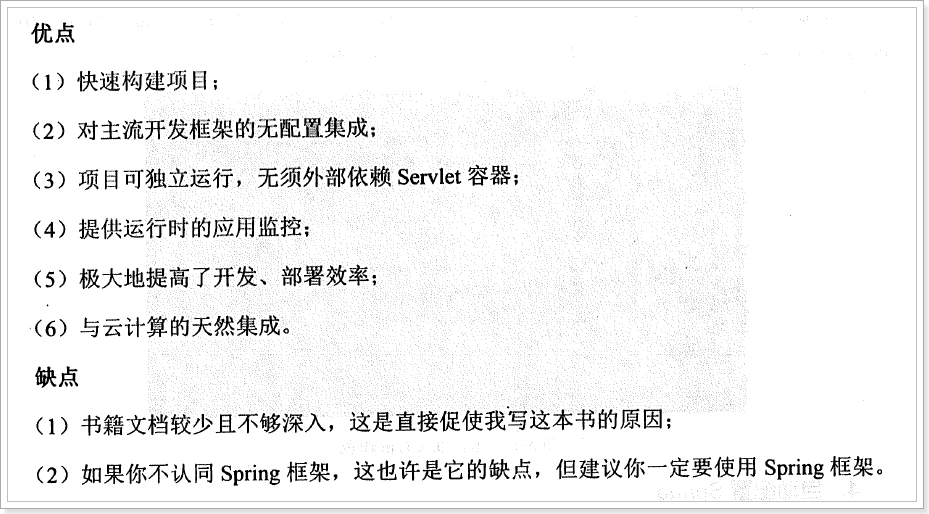
1.3. 快速入门
1.3.1. 设置spring boot的parent
<parent>
<groupId>org.springframework.boot</groupId>
<artifactId>spring-boot-starter-parent</artifactId>
<version>1.5.2.RELEASE</version>
</parent>
说明:Spring boot的项目必须要将parent设置为spring boot的parent,该parent包含了大量默认的配置,大大简化了我们的开发。
1.3.2. 导入spring boot的web支持
<dependency>
<groupId>org.springframework.boot</groupId>
<artifactId>spring-boot-starter-web</artifactId>
</dependency>
1.3.3. 添加Spring boot的插件
<plugin>
<groupId>org.springframework.boot</groupId>
<artifactId>spring-boot-maven-plugin</artifactId>
</plugin>
1.3.4. 编写第一个Spring Boot的应用
@Controller
@SpringBootApplication
@Configuration
public class HelloApplication {
@RequestMapping("hello")
@ResponseBody
public String hello(){
return "hello world!";
}
public static void main(String[] args) {
SpringApplication.run(HelloApplication.class, args);
}
}
代码说明:
1、@SpringBootApplication:Spring Boot项目的核心注解,主要目的是开启自动配置。;
2、@Configuration:这是一个配置Spring的配置类;
3、@Controller:标明这是一个SpringMVC的Controller控制器;
4、main方法:在main方法中启动一个应用,即:这个应用的入口;
1.3.5. 启动应用
在Spring Boot项目中,启动的方式有两种,一种是直接run Java Application另外一种是通过Spring Boot的Maven插件运行。
第一种:

第二种:
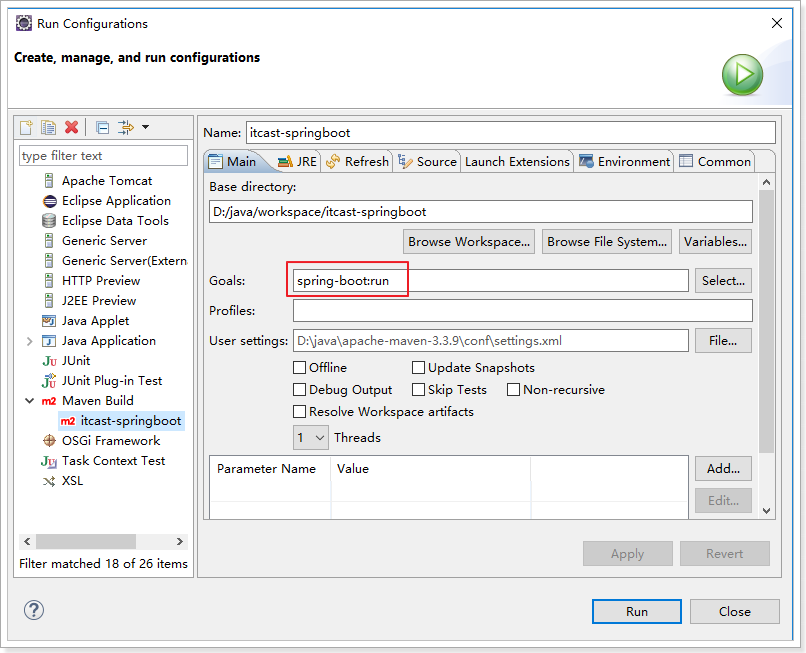
启动效果:

看到如下信息就说明启动成功了:
INFO 6188 --- [ main] c.i.springboot.demo.HelloApplication : Started HelloApplication in 3.281 seconds (JVM running for 3.601)
1.3.6. 测试
打开浏览器,输入地址:
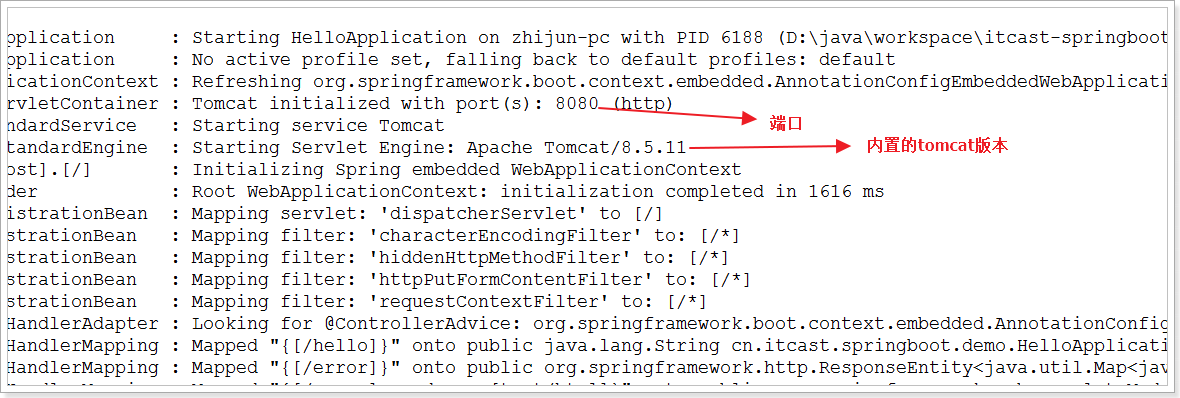
效果:

1.4. Spring Boot的核心
1.4.1. 入口类和@SpringBootApplication
Spring Boot的项目一般都会有*Application的入口类,入口类中会有main方法,这是一个标准的Java应用程序的入口方法。
@SpringBootApplication注解是Spring Boot的核心注解,它其实是一个组合注解:

该注解主要组合了以下注解:
- @SpringBootConfiguration:这是Spring Boot项目的配置注解,这也是一个组合注解:
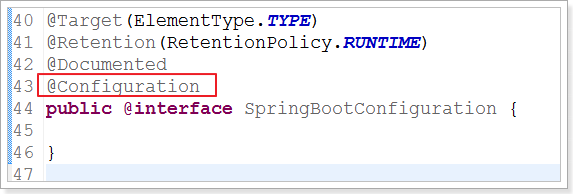
- 在Spring Boot项目中推荐使用@ SpringBootConfiguration替代@Configuration
- @EnableAutoConfiguration:启用自动配置,该注解会使Spring Boot根据项目中依赖的jar包自动配置项目的配置项:
a) 如:我们添加了spring-boot-starter-web的依赖,项目中也就会引入SpringMVC的依赖,Spring Boot就会自动配置tomcat和SpringMVC
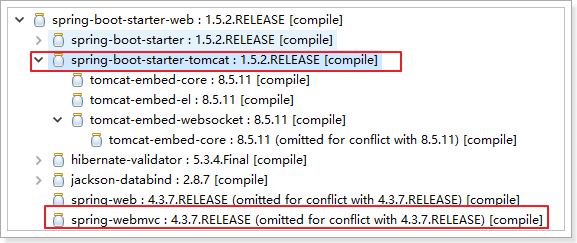
4,@ComponentScan:默认扫描@SpringBootApplication所在类的同级目录以及它的子目录。
1.4.2. 关闭自动配置
通过上述,我们得知,Spring Boot会根据项目中的jar包依赖,自动做出配置,Spring Boot支持的自动配置如下(非常多):
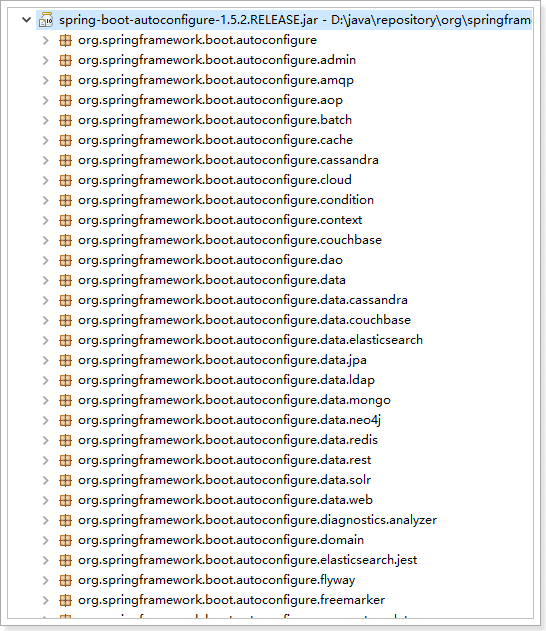
如果我们不需要Spring Boot自动配置,想关闭某一项的自动配置,该如何设置呢?
比如:我们不想自动配置Redis,想手动配置。

当然了,其他的配置就类似了。
1.4.3. 自定义Banner
启动Spring Boot项目后会看到这样的图案:

这个图片其实是可以自定义的:
- 打开网站:http://patorjk.com/software/taag/#p=display&h=3&v=3&f=4Max&t=itcast%20Spring%20Boot
- 拷贝生成的字符到一个文本文件中,并且将该文件命名为banner.txt
- 将banner.txt拷贝到项目的resources目录中:
- 重新启动程序,查看效果:
如果不想看到任何的banner,也是可以将其关闭的:

1.4.4. 全局配置文件
Spring Boot项目使用一个全局的配置文件application.properties或者是application.yml,在resources目录下或者类路径下的/config下,一般我们放到resources下。
1、 修改tomcat的端口为8088
重新启动应用,查看效果:

2、 修改进入DispatcherServlet的规则为:*.html
测试:
更多的配置:
# ===================================================================
# COMMON SPRING BOOT PROPERTIES
#
# This sample file is provided as a guideline. Do NOT copy it in its
# entirety to your own application. ^^^
# ===================================================================
# ----------------------------------------
# CORE PROPERTIES
# ----------------------------------------
# BANNER
banner.charset=UTF-8 # Banner file encoding.
banner.location=classpath:banner.txt # Banner file location.
banner.image.location=classpath:banner.gif # Banner image file location (jpg/png can also be used).
banner.image.width= # Width of the banner image in chars (default 76)
banner.image.height= # Height of the banner image in chars (default based on image height)
banner.image.margin= # Left hand image margin in chars (default 2)
banner.image.invert= # If images should be inverted for dark terminal themes (default false)
# LOGGING
logging.config= # Location of the logging configuration file. For instance `classpath:logback.xml` for Logback
logging.exception-conversion-word=%wEx # Conversion word used when logging exceptions.
logging.file= # Log file name. For instance `myapp.log`
logging.level.*= # Log levels severity mapping. For instance `logging.level.org.springframework=DEBUG`
logging.path= # Location of the log file. For instance `/var/log`
logging.pattern.console= # Appender pattern for output to the console. Only supported with the default logback setup.
logging.pattern.file= # Appender pattern for output to the file. Only supported with the default logback setup.
logging.pattern.level= # Appender pattern for log level (default %5p). Only supported with the default logback setup.
logging.register-shutdown-hook=false # Register a shutdown hook for the logging system when it is initialized.
# AOP
spring.aop.auto=true # Add @EnableAspectJAutoProxy.
spring.aop.proxy-target-class=false # Whether subclass-based (CGLIB) proxies are to be created (true) as opposed to standard Java interface-based proxies (false).
# IDENTITY (ContextIdApplicationContextInitializer)
spring.application.index= # Application index.
spring.application.name= # Application name.
# ADMIN (SpringApplicationAdminJmxAutoConfiguration)
spring.application.admin.enabled=false # Enable admin features for the application.
spring.application.admin.jmx-name=org.springframework.boot:type=Admin,name=SpringApplication # JMX name of the application admin MBean.
# AUTO-CONFIGURATION
spring.autoconfigure.exclude= # Auto-configuration classes to exclude.
# SPRING CORE
spring.beaninfo.ignore=true # Skip search of BeanInfo classes.
# SPRING CACHE (CacheProperties)
spring.cache.cache-names= # Comma-separated list of cache names to create if supported by the underlying cache manager.
spring.cache.caffeine.spec= # The spec to use to create caches. Check CaffeineSpec for more details on the spec format.
spring.cache.couchbase.expiration=0 # Entry expiration in milliseconds. By default the entries never expire.
spring.cache.ehcache.config= # The location of the configuration file to use to initialize EhCache.
spring.cache.guava.spec= # The spec to use to create caches. Check CacheBuilderSpec for more details on the spec format.
spring.cache.infinispan.config= # The location of the configuration file to use to initialize Infinispan.
spring.cache.jcache.config= # The location of the configuration file to use to initialize the cache manager.
spring.cache.jcache.provider= # Fully qualified name of the CachingProvider implementation to use to retrieve the JSR-107 compliant cache manager. Only needed if more than one JSR-107 implementation is available on the classpath.
spring.cache.type= # Cache type, auto-detected according to the environment by default.
# SPRING CONFIG - using environment property only (ConfigFileApplicationListener)
spring.config.location= # Config file locations.
spring.config.name=application # Config file name.
# HAZELCAST (HazelcastProperties)
spring.hazelcast.config= # The location of the configuration file to use to initialize Hazelcast.
# PROJECT INFORMATION (ProjectInfoProperties)
spring.info.build.location=classpath:META-INF/build-info.properties # Location of the generated build-info.properties file.
spring.info.git.location=classpath:git.properties # Location of the generated git.properties file.
# JMX
spring.jmx.default-domain= # JMX domain name.
spring.jmx.enabled=true # Expose management beans to the JMX domain.
spring.jmx.server=mbeanServer # MBeanServer bean name.
# Email (MailProperties)
spring.mail.default-encoding=UTF-8 # Default MimeMessage encoding.
spring.mail.host= # SMTP server host. For instance `smtp.example.com`
spring.mail.jndi-name= # Session JNDI name. When set, takes precedence to others mail settings.
spring.mail.password= # Login password of the SMTP server.
spring.mail.port= # SMTP server port.
spring.mail.properties.*= # Additional JavaMail session properties.
spring.mail.protocol=smtp # Protocol used by the SMTP server.
spring.mail.test-connection=false # Test that the mail server is available on startup.
spring.mail.username= # Login user of the SMTP server.
# APPLICATION SETTINGS (SpringApplication)
spring.main.banner-mode=console # Mode used to display the banner when the application runs.
spring.main.sources= # Sources (class name, package name or XML resource location) to include in the ApplicationContext.
spring.main.web-environment= # Run the application in a web environment (auto-detected by default).
# FILE ENCODING (FileEncodingApplicationListener)
spring.mandatory-file-encoding= # Expected character encoding the application must use.
# INTERNATIONALIZATION (MessageSourceAutoConfiguration)
spring.messages.always-use-message-format=false # Set whether to always apply the MessageFormat rules, parsing even messages without arguments.
spring.messages.basename=messages # Comma-separated list of basenames, each following the ResourceBundle convention.
spring.messages.cache-seconds=-1 # Loaded resource bundle files cache expiration, in seconds. When set to -1, bundles are cached forever.
spring.messages.encoding=UTF-8 # Message bundles encoding.
spring.messages.fallback-to-system-locale=true # Set whether to fall back to the system Locale if no files for a specific Locale have been found.
# OUTPUT
spring.output.ansi.enabled=detect # Configure the ANSI output.
# PID FILE (ApplicationPidFileWriter)
spring.pid.fail-on-write-error= # Fail if ApplicationPidFileWriter is used but it cannot write the PID file.
spring.pid.file= # Location of the PID file to write (if ApplicationPidFileWriter is used).
# PROFILES
spring.profiles.active= # Comma-separated list (or list if using YAML) of active profiles.
spring.profiles.include= # Unconditionally activate the specified comma separated profiles (or list of profiles if using YAML).
# SENDGRID (SendGridAutoConfiguration)
spring.sendgrid.api-key= # SendGrid api key (alternative to username/password)
spring.sendgrid.username= # SendGrid account username
spring.sendgrid.password= # SendGrid account password
spring.sendgrid.proxy.host= # SendGrid proxy host
spring.sendgrid.proxy.port= # SendGrid proxy port
# ----------------------------------------
# WEB PROPERTIES
# ----------------------------------------
# EMBEDDED SERVER CONFIGURATION (ServerProperties)
server.address= # Network address to which the server should bind to.
server.compression.enabled=false # If response compression is enabled.
server.compression.excluded-user-agents= # List of user-agents to exclude from compression.
server.compression.mime-types= # Comma-separated list of MIME types that should be compressed. For instance `text/html,text/css,application/json`
server.compression.min-response-size= # Minimum response size that is required for compression to be performed. For instance 2048
server.connection-timeout= # Time in milliseconds that connectors will wait for another HTTP request before closing the connection. When not set, the connector's container-specific default will be used. Use a value of -1 to indicate no (i.e. infinite) timeout.
server.context-parameters.*= # Servlet context init parameters. For instance `server.context-parameters.a=alpha`
server.context-path= # Context path of the application.
server.display-name=application # Display name of the application.
server.max-http-header-size=0 # Maximum size in bytes of the HTTP message header.
server.error.include-stacktrace=never # When to include a "stacktrace" attribute.
server.error.path=/error # Path of the error controller.
server.error.whitelabel.enabled=true # Enable the default error page displayed in browsers in case of a server error.
server.jetty.acceptors= # Number of acceptor threads to use.
server.jetty.max-http-post-size=0 # Maximum size in bytes of the HTTP post or put content.
server.jetty.selectors= # Number of selector threads to use.
server.jsp-servlet.class-name=org.apache.jasper.servlet.JspServlet # The class name of the JSP servlet.
server.jsp-servlet.init-parameters.*= # Init parameters used to configure the JSP servlet
server.jsp-servlet.registered=true # Whether or not the JSP servlet is registered
server.port=8080 # Server HTTP port.
server.server-header= # Value to use for the Server response header (no header is sent if empty)
server.servlet-path=/ # Path of the main dispatcher servlet.
server.use-forward-headers= # If X-Forwarded-* headers should be applied to the HttpRequest.
server.session.cookie.comment= # Comment for the session cookie.
server.session.cookie.domain= # Domain for the session cookie.
server.session.cookie.http-only= # "HttpOnly" flag for the session cookie.
server.session.cookie.max-age= # Maximum age of the session cookie in seconds.
server.session.cookie.name= # Session cookie name.
server.session.cookie.path= # Path of the session cookie.
server.session.cookie.secure= # "Secure" flag for the session cookie.
server.session.persistent=false # Persist session data between restarts.
server.session.store-dir= # Directory used to store session data.
server.session.timeout= # Session timeout in seconds.
server.session.tracking-modes= # Session tracking modes (one or more of the following: "cookie", "url", "ssl").
server.ssl.ciphers= # Supported SSL ciphers.
server.ssl.client-auth= # Whether client authentication is wanted ("want") or needed ("need"). Requires a trust store.
server.ssl.enabled= # Enable SSL support.
server.ssl.enabled-protocols= # Enabled SSL protocols.
server.ssl.key-alias= # Alias that identifies the key in the key store.
server.ssl.key-password= # Password used to access the key in the key store.
server.ssl.key-store= # Path to the key store that holds the SSL certificate (typically a jks file).
server.ssl.key-store-password= # Password used to access the key store.
server.ssl.key-store-provider= # Provider for the key store.
server.ssl.key-store-type= # Type of the key store.
server.ssl.protocol=TLS # SSL protocol to use.
server.ssl.trust-store= # Trust store that holds SSL certificates.
server.ssl.trust-store-password= # Password used to access the trust store.
server.ssl.trust-store-provider= # Provider for the trust store.
server.ssl.trust-store-type= # Type of the trust store.
server.tomcat.accept-count= # Maximum queue length for incoming connection requests when all possible request processing threads are in use.
server.tomcat.accesslog.buffered=true # Buffer output such that it is only flushed periodically.
server.tomcat.accesslog.directory=logs # Directory in which log files are created. Can be relative to the tomcat base dir or absolute.
server.tomcat.accesslog.enabled=false # Enable access log.
server.tomcat.accesslog.pattern=common # Format pattern for access logs.
server.tomcat.accesslog.prefix=access_log # Log file name prefix.
server.tomcat.accesslog.rename-on-rotate=false # Defer inclusion of the date stamp in the file name until rotate time.
server.tomcat.accesslog.request-attributes-enabled=false # Set request attributes for IP address, Hostname, protocol and port used for the request.
server.tomcat.accesslog.rotate=true # Enable access log rotation.
server.tomcat.accesslog.suffix=.log # Log file name suffix.
server.tomcat.additional-tld-skip-patterns= # Comma-separated list of additional patterns that match jars to ignore for TLD scanning.
server.tomcat.background-processor-delay=30 # Delay in seconds between the invocation of backgroundProcess methods.
server.tomcat.basedir= # Tomcat base directory. If not specified a temporary directory will be used.
server.tomcat.internal-proxies=10\\.\\d{1,3}\\.\\d{1,3}\\.\\d{1,3}|\\
192\\.168\\.\\d{1,3}\\.\\d{1,3}|\\
169\\.254\\.\\d{1,3}\\.\\d{1,3}|\\
127\\.\\d{1,3}\\.\\d{1,3}\\.\\d{1,3}|\\
172\\.1[6-9]{1}\\.\\d{1,3}\\.\\d{1,3}|\\
172\\.2[0-9]{1}\\.\\d{1,3}\\.\\d{1,3}|\\
172\\.3[0-1]{1}\\.\\d{1,3}\\.\\d{1,3} # regular expression matching trusted IP addresses.
server.tomcat.max-connections= # Maximum number of connections that the server will accept and process at any given time.
server.tomcat.max-http-post-size=0 # Maximum size in bytes of the HTTP post content.
server.tomcat.max-threads=0 # Maximum amount of worker threads.
server.tomcat.min-spare-threads=0 # Minimum amount of worker threads.
server.tomcat.port-header=X-Forwarded-Port # Name of the HTTP header used to override the original port value.
server.tomcat.protocol-header= # Header that holds the incoming protocol, usually named "X-Forwarded-Proto".
server.tomcat.protocol-header-https-value=https # Value of the protocol header that indicates that the incoming request uses SSL.
server.tomcat.redirect-context-root= # Whether requests to the context root should be redirected by appending a / to the path.
server.tomcat.remote-ip-header= # Name of the http header from which the remote ip is extracted. For instance `X-FORWARDED-FOR`
server.tomcat.uri-encoding=UTF-8 # Character encoding to use to decode the URI.
server.undertow.accesslog.dir= # Undertow access log directory.
server.undertow.accesslog.enabled=false # Enable access log.
server.undertow.accesslog.pattern=common # Format pattern for access logs.
server.undertow.accesslog.prefix=access_log. # Log file name prefix.
server.undertow.accesslog.rotate=true # Enable access log rotation.
server.undertow.accesslog.suffix=log # Log file name suffix.
server.undertow.buffer-size= # Size of each buffer in bytes.
server.undertow.buffers-per-region= # Number of buffer per region.
server.undertow.direct-buffers= # Allocate buffers outside the Java heap.
server.undertow.io-threads= # Number of I/O threads to create for the worker.
server.undertow.max-http-post-size=0 # Maximum size in bytes of the HTTP post content.
server.undertow.worker-threads= # Number of worker threads.
# FREEMARKER (FreeMarkerAutoConfiguration)
spring.freemarker.allow-request-override=false # Set whether HttpServletRequest attributes are allowed to override (hide) controller generated model attributes of the same name.
spring.freemarker.allow-session-override=false # Set whether HttpSession attributes are allowed to override (hide) controller generated model attributes of the same name.
spring.freemarker.cache=false # Enable template caching.
spring.freemarker.charset=UTF-8 # Template encoding.
spring.freemarker.check-template-location=true # Check that the templates location exists.
spring.freemarker.content-type=text/html # Content-Type value.
spring.freemarker.enabled=true # Enable MVC view resolution for this technology.
spring.freemarker.expose-request-attributes=false # Set whether all request attributes should be added to the model prior to merging with the template.
spring.freemarker.expose-session-attributes=false # Set whether all HttpSession attributes should be added to the model prior to merging with the template.
spring.freemarker.expose-spring-macro-helpers=true # Set whether to expose a RequestContext for use by Spring's macro library, under the name "springMacroRequestContext".
spring.freemarker.prefer-file-system-access=true # Prefer file system access for template loading. File system access enables hot detection of template changes.
spring.freemarker.prefix= # Prefix that gets prepended to view names when building a URL.
spring.freemarker.request-context-attribute= # Name of the RequestContext attribute for all views.
spring.freemarker.settings.*= # Well-known FreeMarker keys which will be passed to FreeMarker's Configuration.
spring.freemarker.suffix= # Suffix that gets appended to view names when building a URL.
spring.freemarker.template-loader-path=classpath:/templates/ # Comma-separated list of template paths.
spring.freemarker.view-names= # White list of view names that can be resolved.
# GROOVY TEMPLATES (GroovyTemplateAutoConfiguration)
spring.groovy.template.allow-request-override=false # Set whether HttpServletRequest attributes are allowed to override (hide) controller generated model attributes of the same name.
spring.groovy.template.allow-session-override=false # Set whether HttpSession attributes are allowed to override (hide) controller generated model attributes of the same name.
spring.groovy.template.cache= # Enable template caching.
spring.groovy.template.charset=UTF-8 # Template encoding.
spring.groovy.template.check-template-location=true # Check that the templates location exists.
spring.groovy.template.configuration.*= # See GroovyMarkupConfigurer
spring.groovy.template.content-type=test/html # Content-Type value.
spring.groovy.template.enabled=true # Enable MVC view resolution for this technology.
spring.groovy.template.expose-request-attributes=false # Set whether all request attributes should be added to the model prior to merging with the template.
spring.groovy.template.expose-session-attributes=false # Set whether all HttpSession attributes should be added to the model prior to merging with the template.
spring.groovy.template.expose-spring-macro-helpers=true # Set whether to expose a RequestContext for use by Spring's macro library, under the name "springMacroRequestContext".
spring.groovy.template.prefix= # Prefix that gets prepended to view names when building a URL.
spring.groovy.template.request-context-attribute= # Name of the RequestContext attribute for all views.
spring.groovy.template.resource-loader-path=classpath:/templates/ # Template path.
spring.groovy.template.suffix=.tpl # Suffix that gets appended to view names when building a URL.
spring.groovy.template.view-names= # White list of view names that can be resolved.
# SPRING HATEOAS (HateoasProperties)
spring.hateoas.use-hal-as-default-json-media-type=true # Specify if application/hal+json responses should be sent to requests that accept application/json.
# HTTP message conversion
spring.http.converters.preferred-json-mapper=jackson # Preferred JSON mapper to use for HTTP message conversion. Set to "gson" to force the use of Gson when both it and Jackson are on the classpath.
# HTTP encoding (HttpEncodingProperties)
spring.http.encoding.charset=UTF-8 # Charset of HTTP requests and responses. Added to the "Content-Type" header if not set explicitly.
spring.http.encoding.enabled=true # Enable http encoding support.
spring.http.encoding.force= # Force the encoding to the configured charset on HTTP requests and responses.
spring.http.encoding.force-request= # Force the encoding to the configured charset on HTTP requests. Defaults to true when "force" has not been specified.
spring.http.encoding.force-response= # Force the encoding to the configured charset on HTTP responses.
spring.http.encoding.mapping= # Locale to Encoding mapping.
# MULTIPART (MultipartProperties)
spring.http.multipart.enabled=true # Enable support of multi-part uploads.
spring.http.multipart.file-size-threshold=0 # Threshold after which files will be written to disk. Values can use the suffixed "MB" or "KB" to indicate a Megabyte or Kilobyte size.
spring.http.multipart.location= # Intermediate location of uploaded files.
spring.http.multipart.max-file-size=1MB # Max file size. Values can use the suffixed "MB" or "KB" to indicate a Megabyte or Kilobyte size.
spring.http.multipart.max-request-size=10MB # Max request size. Values can use the suffixed "MB" or "KB" to indicate a Megabyte or Kilobyte size.
spring.http.multipart.resolve-lazily=false # Whether to resolve the multipart request lazily at the time of file or parameter access.
# JACKSON (JacksonProperties)
spring.jackson.date-format= # Date format string or a fully-qualified date format class name. For instance `yyyy-MM-dd HH:mm:ss`.
spring.jackson.default-property-inclusion= # Controls the inclusion of properties during serialization.
spring.jackson.deserialization.*= # Jackson on/off features that affect the way Java objects are deserialized.
spring.jackson.generator.*= # Jackson on/off features for generators.
spring.jackson.joda-date-time-format= # Joda date time format string. If not configured, "date-format" will be used as a fallback if it is configured with a format string.
spring.jackson.locale= # Locale used for formatting.
spring.jackson.mapper.*= # Jackson general purpose on/off features.
spring.jackson.parser.*= # Jackson on/off features for parsers.
spring.jackson.property-naming-strategy= # One of the constants on Jackson's PropertyNamingStrategy. Can also be a fully-qualified class name of a PropertyNamingStrategy subclass.
spring.jackson.serialization.*= # Jackson on/off features that affect the way Java objects are serialized.
spring.jackson.time-zone= # Time zone used when formatting dates. For instance `America/Los_Angeles`
# JERSEY (JerseyProperties)
spring.jersey.application-path= # Path that serves as the base URI for the application. Overrides the value of "@ApplicationPath" if specified.
spring.jersey.filter.order=0 # Jersey filter chain order.
spring.jersey.init.*= # Init parameters to pass to Jersey via the servlet or filter.
spring.jersey.servlet.load-on-startup=-1 # Load on startup priority of the Jersey servlet.
spring.jersey.type=servlet # Jersey integration type.
# SPRING LDAP (LdapProperties)
spring.ldap.urls= # LDAP URLs of the server.
spring.ldap.base= # Base suffix from which all operations should originate.
spring.ldap.username= # Login user of the server.
spring.ldap.password= # Login password of the server.
spring.ldap.base-environment.*= # LDAP specification settings.
# EMBEDDED LDAP (EmbeddedLdapProperties)
spring.ldap.embedded.base-dn= # The base DN
spring.ldap.embedded.credential.username= # Embedded LDAP username.
spring.ldap.embedded.credential.password= # Embedded LDAP password.
spring.ldap.embedded.ldif=classpath:schema.ldif # Schema (LDIF) script resource reference.
spring.ldap.embedded.port= # Embedded LDAP port.
spring.ldap.embedded.validation.enabled=true # Enable LDAP schema validation.
spring.ldap.embedded.validation.schema= # Path to the custom schema.
# SPRING MOBILE DEVICE VIEWS (DeviceDelegatingViewResolverAutoConfiguration)
spring.mobile.devicedelegatingviewresolver.enable-fallback=false # Enable support for fallback resolution.
spring.mobile.devicedelegatingviewresolver.enabled=false # Enable device view resolver.
spring.mobile.devicedelegatingviewresolver.mobile-prefix=mobile/ # Prefix that gets prepended to view names for mobile devices.
spring.mobile.devicedelegatingviewresolver.mobile-suffix= # Suffix that gets appended to view names for mobile devices.
spring.mobile.devicedelegatingviewresolver.normal-prefix= # Prefix that gets prepended to view names for normal devices.
spring.mobile.devicedelegatingviewresolver.normal-suffix= # Suffix that gets appended to view names for normal devices.
spring.mobile.devicedelegatingviewresolver.tablet-prefix=tablet/ # Prefix that gets prepended to view names for tablet devices.
spring.mobile.devicedelegatingviewresolver.tablet-suffix= # Suffix that gets appended to view names for tablet devices.
# SPRING MOBILE SITE PREFERENCE (SitePreferenceAutoConfiguration)
spring.mobile.sitepreference.enabled=true # Enable SitePreferenceHandler.
# MUSTACHE TEMPLATES (MustacheAutoConfiguration)
spring.mustache.allow-request-override= # Set whether HttpServletRequest attributes are allowed to override (hide) controller generated model attributes of the same name.
spring.mustache.allow-session-override= # Set whether HttpSession attributes are allowed to override (hide) controller generated model attributes of the same name.
spring.mustache.cache= # Enable template caching.
spring.mustache.charset= # Template encoding.
spring.mustache.check-template-location= # Check that the templates location exists.
spring.mustache.content-type= # Content-Type value.
spring.mustache.enabled= # Enable MVC view resolution for this technology.
spring.mustache.expose-request-attributes= # Set whether all request attributes should be added to the model prior to merging with the template.
spring.mustache.expose-session-attributes= # Set whether all HttpSession attributes should be added to the model prior to merging with the template.
spring.mustache.expose-spring-macro-helpers= # Set whether to expose a RequestContext for use by Spring's macro library, under the name "springMacroRequestContext".
spring.mustache.prefix=classpath:/templates/ # Prefix to apply to template names.
spring.mustache.request-context-attribute= # Name of the RequestContext attribute for all views.
spring.mustache.suffix=.html # Suffix to apply to template names.
spring.mustache.view-names= # White list of view names that can be resolved.
# SPRING MVC (WebMvcProperties)
spring.mvc.async.request-timeout= # Amount of time (in milliseconds) before asynchronous request handling times out.
spring.mvc.date-format= # Date format to use. For instance `dd/MM/yyyy`.
spring.mvc.dispatch-trace-request=false # Dispatch TRACE requests to the FrameworkServlet doService method.
spring.mvc.dispatch-options-request=true # Dispatch OPTIONS requests to the FrameworkServlet doService method.
spring.mvc.favicon.enabled=true # Enable resolution of favicon.ico.
spring.mvc.formcontent.putfilter.enabled=true # Enable Spring's HttpPutFormContentFilter.
spring.mvc.ignore-default-model-on-redirect=true # If the content of the "default" model should be ignored during redirect scenarios.
spring.mvc.locale= # Locale to use. By default, this locale is overridden by the "Accept-Language" header.
spring.mvc.locale-resolver=accept-header # Define how the locale should be resolved.
spring.mvc.log-resolved-exception=false # Enable warn logging of exceptions resolved by a "HandlerExceptionResolver".
spring.mvc.media-types.*= # Maps file extensions to media types for content negotiation.
spring.mvc.message-codes-resolver-format= # Formatting strategy for message codes. For instance `PREFIX_ERROR_CODE`.
spring.mvc.servlet.load-on-startup=-1 # Load on startup priority of the Spring Web Services servlet.
spring.mvc.static-path-pattern=/** # Path pattern used for static resources.
spring.mvc.throw-exception-if-no-handler-found=false # If a "NoHandlerFoundException" should be thrown if no Handler was found to process a request.
spring.mvc.view.prefix= # Spring MVC view prefix.
spring.mvc.view.suffix= # Spring MVC view suffix.
# SPRING RESOURCES HANDLING (ResourceProperties)
spring.resources.add-mappings=true # Enable default resource handling.
spring.resources.cache-period= # Cache period for the resources served by the resource handler, in seconds.
spring.resources.chain.cache=true # Enable caching in the Resource chain.
spring.resources.chain.enabled= # Enable the Spring Resource Handling chain. Disabled by default unless at least one strategy has been enabled.
spring.resources.chain.gzipped=false # Enable resolution of already gzipped resources.
spring.resources.chain.html-application-cache=false # Enable HTML5 application cache manifest rewriting.
spring.resources.chain.strategy.content.enabled=false # Enable the content Version Strategy.
spring.resources.chain.strategy.content.paths=/** # Comma-separated list of patterns to apply to the Version Strategy.
spring.resources.chain.strategy.fixed.enabled=false # Enable the fixed Version Strategy.
spring.resources.chain.strategy.fixed.paths=/** # Comma-separated list of patterns to apply to the Version Strategy.
spring.resources.chain.strategy.fixed.version= # Version string to use for the Version Strategy.
spring.resources.static-locations=classpath:/META-INF/resources/,classpath:/resources/,classpath:/static/,classpath:/public/ # Locations of static resources.
# SPRING SESSION (SessionProperties)
spring.session.hazelcast.flush-mode=on-save # Sessions flush mode.
spring.session.hazelcast.map-name=spring:session:sessions # Name of the map used to store sessions.
spring.session.jdbc.initializer.enabled= # Create the required session tables on startup if necessary. Enabled automatically if the default table name is set or a custom schema is configured.
spring.session.jdbc.schema=classpath:org/springframework/session/jdbc/schema-@@platform@@.sql # Path to the SQL file to use to initialize the database schema.
spring.session.jdbc.table-name=SPRING_SESSION # Name of database table used to store sessions.
spring.session.mongo.collection-name=sessions # Collection name used to store sessions.
spring.session.redis.flush-mode=on-save # Sessions flush mode.
spring.session.redis.namespace= # Namespace for keys used to store sessions.
spring.session.store-type= # Session store type.
# SPRING SOCIAL (SocialWebAutoConfiguration)
spring.social.auto-connection-views=false # Enable the connection status view for supported providers.
# SPRING SOCIAL FACEBOOK (FacebookAutoConfiguration)
spring.social.facebook.app-id= # your application's Facebook App ID
spring.social.facebook.app-secret= # your application's Facebook App Secret
# SPRING SOCIAL LINKEDIN (LinkedInAutoConfiguration)
spring.social.linkedin.app-id= # your application's LinkedIn App ID
spring.social.linkedin.app-secret= # your application's LinkedIn App Secret
# SPRING SOCIAL TWITTER (TwitterAutoConfiguration)
spring.social.twitter.app-id= # your application's Twitter App ID
spring.social.twitter.app-secret= # your application's Twitter App Secret
# THYMELEAF (ThymeleafAutoConfiguration)
spring.thymeleaf.cache=true # Enable template caching.
spring.thymeleaf.check-template=true # Check that the template exists before rendering it.
spring.thymeleaf.check-template-location=true # Check that the templates location exists.
spring.thymeleaf.content-type=text/html # Content-Type value.
spring.thymeleaf.enabled=true # Enable MVC Thymeleaf view resolution.
spring.thymeleaf.encoding=UTF-8 # Template encoding.
spring.thymeleaf.excluded-view-names= # Comma-separated list of view names that should be excluded from resolution.
spring.thymeleaf.mode=HTML5 # Template mode to be applied to templates. See also StandardTemplateModeHandlers.
spring.thymeleaf.prefix=classpath:/templates/ # Prefix that gets prepended to view names when building a URL.
spring.thymeleaf.suffix=.html # Suffix that gets appended to view names when building a URL.
spring.thymeleaf.template-resolver-order= # Order of the template resolver in the chain.
spring.thymeleaf.view-names= # Comma-separated list of view names that can be resolved.
# SPRING WEB SERVICES (WebServicesProperties)
spring.webservices.path=/services # Path that serves as the base URI for the services.
spring.webservices.servlet.init= # Servlet init parameters to pass to Spring Web Services.
spring.webservices.servlet.load-on-startup=-1 # Load on startup priority of the Spring Web Services servlet.
# ----------------------------------------
# SECURITY PROPERTIES
# ----------------------------------------
# SECURITY (SecurityProperties)
security.basic.authorize-mode=role # Security authorize mode to apply.
security.basic.enabled=true # Enable basic authentication.
security.basic.path=/** # Comma-separated list of paths to secure.
security.basic.realm=Spring # HTTP basic realm name.
security.enable-csrf=false # Enable Cross Site Request Forgery support.
security.filter-order=0 # Security filter chain order.
security.filter-dispatcher-types=ASYNC, FORWARD, INCLUDE, REQUEST # Security filter chain dispatcher types.
security.headers.cache=true # Enable cache control HTTP headers.
security.headers.content-security-policy= # Value for content security policy header.
security.headers.content-security-policy-mode=default # Content security policy mode.
security.headers.content-type=true # Enable "X-Content-Type-Options" header.
security.headers.frame=true # Enable "X-Frame-Options" header.
security.headers.hsts=all # HTTP Strict Transport Security (HSTS) mode (none, domain, all).
security.headers.xss=true # Enable cross site scripting (XSS) protection.
security.ignored= # Comma-separated list of paths to exclude from the default secured paths.
security.require-ssl=false # Enable secure channel for all requests.
security.sessions=stateless # Session creation policy (always, never, if_required, stateless).
security.user.name=user # Default user name.
security.user.password= # Password for the default user name. A random password is logged on startup by default.
security.user.role=USER # Granted roles for the default user name.
# SECURITY OAUTH2 CLIENT (OAuth2ClientProperties)
security.oauth2.client.client-id= # OAuth2 client id.
security.oauth2.client.client-secret= # OAuth2 client secret. A random secret is generated by default
# SECURITY OAUTH2 RESOURCES (ResourceServerProperties)
security.oauth2.resource.filter-order= # The order of the filter chain used to authenticate tokens.
security.oauth2.resource.id= # Identifier of the resource.
security.oauth2.resource.jwt.key-uri= # The URI of the JWT token. Can be set if the value is not available and the key is public.
security.oauth2.resource.jwt.key-value= # The verification key of the JWT token. Can either be a symmetric secret or PEM-encoded RSA public key.
security.oauth2.resource.prefer-token-info=true # Use the token info, can be set to false to use the user info.
security.oauth2.resource.service-id=resource #
security.oauth2.resource.token-info-uri= # URI of the token decoding endpoint.
security.oauth2.resource.token-type= # The token type to send when using the userInfoUri.
security.oauth2.resource.user-info-uri= # URI of the user endpoint.
# SECURITY OAUTH2 SSO (OAuth2SsoProperties)
security.oauth2.sso.filter-order= # Filter order to apply if not providing an explicit WebSecurityConfigurerAdapter
security.oauth2.sso.login-path=/login # Path to the login page, i.e. the one that triggers the redirect to the OAuth2 Authorization Server
# ----------------------------------------
# DATA PROPERTIES
# ----------------------------------------
# FLYWAY (FlywayProperties)
flyway.baseline-description= #
flyway.baseline-version=1 # version to start migration
flyway.baseline-on-migrate= #
flyway.check-location=false # Check that migration scripts location exists.
flyway.clean-on-validation-error= #
flyway.enabled=true # Enable flyway.
flyway.encoding= #
flyway.ignore-failed-future-migration= #
flyway.init-sqls= # SQL statements to execute to initialize a connection immediately after obtaining it.
flyway.locations=classpath:db/migration # locations of migrations scripts
flyway.out-of-order= #
flyway.password= # JDBC password if you want Flyway to create its own DataSource
flyway.placeholder-prefix= #
flyway.placeholder-replacement= #
flyway.placeholder-suffix= #
flyway.placeholders.*= #
flyway.schemas= # schemas to update
flyway.sql-migration-prefix=V #
flyway.sql-migration-separator= #
flyway.sql-migration-suffix=.sql #
flyway.table= #
flyway.url= # JDBC url of the database to migrate. If not set, the primary configured data source is used.
flyway.user= # Login user of the database to migrate.
flyway.validate-on-migrate= #
# LIQUIBASE (LiquibaseProperties)
liquibase.change-log=classpath:/db/changelog/db.changelog-master.yaml # Change log configuration path.
liquibase.check-change-log-location=true # Check the change log location exists.
liquibase.contexts= # Comma-separated list of runtime contexts to use.
liquibase.default-schema= # Default database schema.
liquibase.drop-first=false # Drop the database schema first.
liquibase.enabled=true # Enable liquibase support.
liquibase.labels= # Comma-separated list of runtime labels to use.
liquibase.parameters.*= # Change log parameters.
liquibase.password= # Login password of the database to migrate.
liquibase.rollback-file= # File to which rollback SQL will be written when an update is performed.
liquibase.url= # JDBC url of the database to migrate. If not set, the primary configured data source is used.
liquibase.user= # Login user of the database to migrate.
# COUCHBASE (CouchbaseProperties)
spring.couchbase.bootstrap-hosts= # Couchbase nodes (host or IP address) to bootstrap from.
spring.couchbase.bucket.name=default # Name of the bucket to connect to.
spring.couchbase.bucket.password= # Password of the bucket.
spring.couchbase.env.endpoints.key-value=1 # Number of sockets per node against the Key/value service.
spring.couchbase.env.endpoints.query=1 # Number of sockets per node against the Query (N1QL) service.
spring.couchbase.env.endpoints.view=1 # Number of sockets per node against the view service.
spring.couchbase.env.ssl.enabled= # Enable SSL support. Enabled automatically if a "keyStore" is provided unless specified otherwise.
spring.couchbase.env.ssl.key-store= # Path to the JVM key store that holds the certificates.
spring.couchbase.env.ssl.key-store-password= # Password used to access the key store.
spring.couchbase.env.timeouts.connect=5000 # Bucket connections timeout in milliseconds.
spring.couchbase.env.timeouts.key-value=2500 # Blocking operations performed on a specific key timeout in milliseconds.
spring.couchbase.env.timeouts.query=7500 # N1QL query operations timeout in milliseconds.
spring.couchbase.env.timeouts.socket-connect=1000 # Socket connect connections timeout in milliseconds.
spring.couchbase.env.timeouts.view=7500 # Regular and geospatial view operations timeout in milliseconds.
# DAO (PersistenceExceptionTranslationAutoConfiguration)
spring.dao.exceptiontranslation.enabled=true # Enable the PersistenceExceptionTranslationPostProcessor.
# CASSANDRA (CassandraProperties)
spring.data.cassandra.cluster-name= # Name of the Cassandra cluster.
spring.data.cassandra.compression=none # Compression supported by the Cassandra binary protocol.
spring.data.cassandra.connect-timeout-millis= # Socket option: connection time out.
spring.data.cassandra.consistency-level= # Queries consistency level.
spring.data.cassandra.contact-points=localhost # Comma-separated list of cluster node addresses.
spring.data.cassandra.fetch-size= # Queries default fetch size.
spring.data.cassandra.keyspace-name= # Keyspace name to use.
spring.data.cassandra.load-balancing-policy= # Class name of the load balancing policy.
spring.data.cassandra.port= # Port of the Cassandra server.
spring.data.cassandra.password= # Login password of the server.
spring.data.cassandra.read-timeout-millis= # Socket option: read time out.
spring.data.cassandra.reconnection-policy= # Reconnection policy class.
spring.data.cassandra.retry-policy= # Class name of the retry policy.
spring.data.cassandra.serial-consistency-level= # Queries serial consistency level.
spring.data.cassandra.schema-action=none # Schema action to take at startup.
spring.data.cassandra.ssl=false # Enable SSL support.
spring.data.cassandra.username= # Login user of the server.
# DATA COUCHBASE (CouchbaseDataProperties)
spring.data.couchbase.auto-index=false # Automatically create views and indexes.
spring.data.couchbase.consistency=read-your-own-writes # Consistency to apply by default on generated queries.
spring.data.couchbase.repositories.enabled=true # Enable Couchbase repositories.
# ELASTICSEARCH (ElasticsearchProperties)
spring.data.elasticsearch.cluster-name=elasticsearch # Elasticsearch cluster name.
spring.data.elasticsearch.cluster-nodes= # Comma-separated list of cluster node addresses. If not specified, starts a client node.
spring.data.elasticsearch.properties.*= # Additional properties used to configure the client.
spring.data.elasticsearch.repositories.enabled=true # Enable Elasticsearch repositories.
# DATA LDAP
spring.data.ldap.repositories.enabled=true # Enable LDAP repositories.
# MONGODB (MongoProperties)
spring.data.mongodb.authentication-database= # Authentication database name.
spring.data.mongodb.database=test # Database name.
spring.data.mongodb.field-naming-strategy= # Fully qualified name of the FieldNamingStrategy to use.
spring.data.mongodb.grid-fs-database= # GridFS database name.
spring.data.mongodb.host=localhost # Mongo server host. Cannot be set with uri.
spring.data.mongodb.password= # Login password of the mongo server. Cannot be set with uri.
spring.data.mongodb.port=27017 # Mongo server port. Cannot be set with uri.
spring.data.mongodb.repositories.enabled=true # Enable Mongo repositories.
spring.data.mongodb.uri=mongodb://localhost/test # Mongo database URI. Cannot be set with host, port and credentials.
spring.data.mongodb.username= # Login user of the mongo server. Cannot be set with uri.
# DATA REDIS
spring.data.redis.repositories.enabled=true # Enable Redis repositories.
# NEO4J (Neo4jProperties)
spring.data.neo4j.compiler= # Compiler to use.
spring.data.neo4j.embedded.enabled=true # Enable embedded mode if the embedded driver is available.
spring.data.neo4j.open-in-view=false # Register OpenSessionInViewInterceptor. Binds a Neo4j Session to the thread for the entire processing of the request.
spring.data.neo4j.password= # Login password of the server.
spring.data.neo4j.repositories.enabled=true # Enable Neo4j repositories.
spring.data.neo4j.uri= # URI used by the driver. Auto-detected by default.
spring.data.neo4j.username= # Login user of the server.
# DATA REST (RepositoryRestProperties)
spring.data.rest.base-path= # Base path to be used by Spring Data REST to expose repository resources.
spring.data.rest.default-page-size= # Default size of pages.
spring.data.rest.detection-strategy=default # Strategy to use to determine which repositories get exposed.
spring.data.rest.enable-enum-translation= # Enable enum value translation via the Spring Data REST default resource bundle.
spring.data.rest.limit-param-name= # Name of the URL query string parameter that indicates how many results to return at once.
spring.data.rest.max-page-size= # Maximum size of pages.
spring.data.rest.page-param-name= # Name of the URL query string parameter that indicates what page to return.
spring.data.rest.return-body-on-create= # Return a response body after creating an entity.
spring.data.rest.return-body-on-update= # Return a response body after updating an entity.
spring.data.rest.sort-param-name= # Name of the URL query string parameter that indicates what direction to sort results.
# SOLR (SolrProperties)
spring.data.solr.host=http://127.0.0.1:8983/solr # Solr host. Ignored if "zk-host" is set.
spring.data.solr.repositories.enabled=true # Enable Solr repositories.
spring.data.solr.zk-host= # ZooKeeper host address in the form HOST:PORT.
# DATASOURCE (DataSourceAutoConfiguration & DataSourceProperties)
spring.datasource.continue-on-error=false # Do not stop if an error occurs while initializing the database.
spring.datasource.data= # Data (DML) script resource references.
spring.datasource.data-username= # User of the database to execute DML scripts (if different).
spring.datasource.data-password= # Password of the database to execute DML scripts (if different).
spring.datasource.dbcp2.*= # Commons DBCP2 specific settings
spring.datasource.driver-class-name= # Fully qualified name of the JDBC driver. Auto-detected based on the URL by default.
spring.datasource.generate-unique-name=false # Generate a random datasource name.
spring.datasource.hikari.*= # Hikari specific settings
spring.datasource.initialize=true # Populate the database using 'data.sql'.
spring.datasource.jmx-enabled=false # Enable JMX support (if provided by the underlying pool).
spring.datasource.jndi-name= # JNDI location of the datasource. Class, url, username & password are ignored when set.
spring.datasource.name=testdb # Name of the datasource.
spring.datasource.password= # Login password of the database.
spring.datasource.platform=all # Platform to use in the schema resource (schema-${platform}.sql).
spring.datasource.schema= # Schema (DDL) script resource references.
spring.datasource.schema-username= # User of the database to execute DDL scripts (if different).
spring.datasource.schema-password= # Password of the database to execute DDL scripts (if different).
spring.datasource.separator=; # Statement separator in SQL initialization scripts.
spring.datasource.sql-script-encoding= # SQL scripts encoding.
spring.datasource.tomcat.*= # Tomcat datasource specific settings
spring.datasource.type= # Fully qualified name of the connection pool implementation to use. By default, it is auto-detected from the classpath.
spring.datasource.url= # JDBC url of the database.
spring.datasource.username=
# JEST (Elasticsearch HTTP client) (JestProperties)
spring.elasticsearch.jest.connection-timeout=3000 # Connection timeout in milliseconds.
spring.elasticsearch.jest.multi-threaded=true # Enable connection requests from multiple execution threads.
spring.elasticsearch.jest.password= # Login password.
spring.elasticsearch.jest.proxy.host= # Proxy host the HTTP client should use.
spring.elasticsearch.jest.proxy.port= # Proxy port the HTTP client should use.
spring.elasticsearch.jest.read-timeout=3000 # Read timeout in milliseconds.
spring.elasticsearch.jest.uris=http://localhost:9200 # Comma-separated list of the Elasticsearch instances to use.
spring.elasticsearch.jest.username= # Login user.
# H2 Web Console (H2ConsoleProperties)
spring.h2.console.enabled=false # Enable the console.
spring.h2.console.path=/h2-console # Path at which the console will be available.
spring.h2.console.settings.trace=false # Enable trace output.
spring.h2.console.settings.web-allow-others=false # Enable remote access.
# JOOQ (JooqAutoConfiguration)
spring.jooq.sql-dialect= # SQLDialect JOOQ used when communicating with the configured datasource. For instance `POSTGRES`
# JPA (JpaBaseConfiguration, HibernateJpaAutoConfiguration)
spring.data.jpa.repositories.enabled=true # Enable JPA repositories.
spring.jpa.database= # Target database to operate on, auto-detected by default. Can be alternatively set using the "databasePlatform" property.
spring.jpa.database-platform= # Name of the target database to operate on, auto-detected by default. Can be alternatively set using the "Database" enum.
spring.jpa.generate-ddl=false # Initialize the schema on startup.
spring.jpa.hibernate.ddl-auto= # DDL mode. This is actually a shortcut for the "hibernate.hbm2ddl.auto" property. Default to "create-drop" when using an embedded database, "none" otherwise.
spring.jpa.hibernate.naming.implicit-strategy= # Hibernate 5 implicit naming strategy fully qualified name.
spring.jpa.hibernate.naming.physical-strategy= # Hibernate 5 physical naming strategy fully qualified name.
spring.jpa.hibernate.naming.strategy= # Hibernate 4 naming strategy fully qualified name. Not supported with Hibernate 5.
spring.jpa.hibernate.use-new-id-generator-mappings= # Use Hibernate's newer IdentifierGenerator for AUTO, TABLE and SEQUENCE.
spring.jpa.open-in-view=true # Register OpenEntityManagerInViewInterceptor. Binds a JPA EntityManager to the thread for the entire processing of the request.
spring.jpa.properties.*= # Additional native properties to set on the JPA provider.
spring.jpa.show-sql=false # Enable logging of SQL statements.
# JTA (JtaAutoConfiguration)
spring.jta.enabled=true # Enable JTA support.
spring.jta.log-dir= # Transaction logs directory.
spring.jta.transaction-manager-id= # Transaction manager unique identifier.
# ATOMIKOS (AtomikosProperties)
spring.jta.atomikos.connectionfactory.borrow-connection-timeout=30 # Timeout, in seconds, for borrowing connections from the pool.
spring.jta.atomikos.connectionfactory.ignore-session-transacted-flag=true # Whether or not to ignore the transacted flag when creating session.
spring.jta.atomikos.connectionfactory.local-transaction-mode=false # Whether or not local transactions are desired.
spring.jta.atomikos.connectionfactory.maintenance-interval=60 # The time, in seconds, between runs of the pool's maintenance thread.
spring.jta.atomikos.connectionfactory.max-idle-time=60 # The time, in seconds, after which connections are cleaned up from the pool.
spring.jta.atomikos.connectionfactory.max-lifetime=0 # The time, in seconds, that a connection can be pooled for before being destroyed. 0 denotes no limit.
spring.jta.atomikos.connectionfactory.max-pool-size=1 # The maximum size of the pool.
spring.jta.atomikos.connectionfactory.min-pool-size=1 # The minimum size of the pool.
spring.jta.atomikos.connectionfactory.reap-timeout=0 # The reap timeout, in seconds, for borrowed connections. 0 denotes no limit.
spring.jta.atomikos.connectionfactory.unique-resource-name=jmsConnectionFactory # The unique name used to identify the resource during recovery.
spring.jta.atomikos.datasource.borrow-connection-timeout=30 # Timeout, in seconds, for borrowing connections from the pool.
spring.jta.atomikos.datasource.default-isolation-level= # Default isolation level of connections provided by the pool.
spring.jta.atomikos.datasource.login-timeout= # Timeout, in seconds, for establishing a database connection.
spring.jta.atomikos.datasource.maintenance-interval=60 # The time, in seconds, between runs of the pool's maintenance thread.
spring.jta.atomikos.datasource.max-idle-time=60 # The time, in seconds, after which connections are cleaned up from the pool.
spring.jta.atomikos.datasource.max-lifetime=0 # The time, in seconds, that a connection can be pooled for before being destroyed. 0 denotes no limit.
spring.jta.atomikos.datasource.max-pool-size=1 # The maximum size of the pool.
spring.jta.atomikos.datasource.min-pool-size=1 # The minimum size of the pool.
spring.jta.atomikos.datasource.reap-timeout=0 # The reap timeout, in seconds, for borrowed connections. 0 denotes no limit.
spring.jta.atomikos.datasource.test-query= # SQL query or statement used to validate a connection before returning it.
spring.jta.atomikos.datasource.unique-resource-name=dataSource # The unique name used to identify the resource during recovery.
spring.jta.atomikos.properties.checkpoint-interval=500 # Interval between checkpoints.
spring.jta.atomikos.properties.console-file-count=1 # Number of debug logs files that can be created.
spring.jta.atomikos.properties.console-file-limit=-1 # How many bytes can be stored at most in debug logs files.
spring.jta.atomikos.properties.console-file-name=tm.out # Debug logs file name.
spring.jta.atomikos.properties.console-log-level=warn # Console log level.
spring.jta.atomikos.properties.default-jta-timeout=10000 # Default timeout for JTA transactions.
spring.jta.atomikos.properties.enable-logging=true # Enable disk logging.
spring.jta.atomikos.properties.force-shutdown-on-vm-exit=false # Specify if a VM shutdown should trigger forced shutdown of the transaction core.
spring.jta.atomikos.properties.log-base-dir= # Directory in which the log files should be stored.
spring.jta.atomikos.properties.log-base-name=tmlog # Transactions log file base name.
spring.jta.atomikos.properties.max-actives=50 # Maximum number of active transactions.
spring.jta.atomikos.properties.max-timeout=300000 # Maximum timeout (in milliseconds) that can be allowed for transactions.
spring.jta.atomikos.properties.output-dir= # Directory in which to store the debug log files.
spring.jta.atomikos.properties.serial-jta-transactions=true # Specify if sub-transactions should be joined when possible.
spring.jta.atomikos.properties.service= # Transaction manager implementation that should be started.
spring.jta.atomikos.properties.threaded-two-phase-commit=true # Use different (and concurrent) threads for two-phase commit on the participating resources.
spring.jta.atomikos.properties.transaction-manager-unique-name= # Transaction manager's unique name.
# BITRONIX
spring.jta.bitronix.connectionfactory.acquire-increment=1 # Number of connections to create when growing the pool.
spring.jta.bitronix.connectionfactory.acquisition-interval=1 # Time, in seconds, to wait before trying to acquire a connection again after an invalid connection was acquired.
spring.jta.bitronix.connectionfactory.acquisition-timeout=30 # Timeout, in seconds, for acquiring connections from the pool.
spring.jta.bitronix.connectionfactory.allow-local-transactions=true # Whether or not the transaction manager should allow mixing XA and non-XA transactions.
spring.jta.bitronix.connectionfactory.apply-transaction-timeout=false # Whether or not the transaction timeout should be set on the XAResource when it is enlisted.
spring.jta.bitronix.connectionfactory.automatic-enlisting-enabled=true # Whether or not resources should be enlisted and delisted automatically.
spring.jta.bitronix.connectionfactory.cache-producers-consumers=true # Whether or not produces and consumers should be cached.
spring.jta.bitronix.connectionfactory.defer-connection-release=true # Whether or not the provider can run many transactions on the same connection and supports transaction interleaving.
spring.jta.bitronix.connectionfactory.ignore-recovery-failures=false # Whether or not recovery failures should be ignored.
spring.jta.bitronix.connectionfactory.max-idle-time=60 # The time, in seconds, after which connections are cleaned up from the pool.
spring.jta.bitronix.connectionfactory.max-pool-size=10 # The maximum size of the pool. 0 denotes no limit.
spring.jta.bitronix.connectionfactory.min-pool-size=0 # The minimum size of the pool.
spring.jta.bitronix.connectionfactory.password= # The password to use to connect to the JMS provider.
spring.jta.bitronix.connectionfactory.share-transaction-connections=false # Whether or not connections in the ACCESSIBLE state can be shared within the context of a transaction.
spring.jta.bitronix.connectionfactory.test-connections=true # Whether or not connections should be tested when acquired from the pool.
spring.jta.bitronix.connectionfactory.two-pc-ordering-position=1 # The position that this resource should take during two-phase commit (always first is Integer.MIN_VALUE, always last is Integer.MAX_VALUE).
spring.jta.bitronix.connectionfactory.unique-name=jmsConnectionFactory # The unique name used to identify the resource during recovery.
spring.jta.bitronix.connectionfactory.use-tm-join=true Whether or not TMJOIN should be used when starting XAResources.
spring.jta.bitronix.connectionfactory.user= # The user to use to connect to the JMS provider.
spring.jta.bitronix.datasource.acquire-increment=1 # Number of connections to create when growing the pool.
spring.jta.bitronix.datasource.acquisition-interval=1 # Time, in seconds, to wait before trying to acquire a connection again after an invalid connection was acquired.
spring.jta.bitronix.datasource.acquisition-timeout=30 # Timeout, in seconds, for acquiring connections from the pool.
spring.jta.bitronix.datasource.allow-local-transactions=true # Whether or not the transaction manager should allow mixing XA and non-XA transactions.
spring.jta.bitronix.datasource.apply-transaction-timeout=false # Whether or not the transaction timeout should be set on the XAResource when it is enlisted.
spring.jta.bitronix.datasource.automatic-enlisting-enabled=true # Whether or not resources should be enlisted and delisted automatically.
spring.jta.bitronix.datasource.cursor-holdability= # The default cursor holdability for connections.
spring.jta.bitronix.datasource.defer-connection-release=true # Whether or not the database can run many transactions on the same connection and supports transaction interleaving.
spring.jta.bitronix.datasource.enable-jdbc4-connection-test= # Whether or not Connection.isValid() is called when acquiring a connection from the pool.
spring.jta.bitronix.datasource.ignore-recovery-failures=false # Whether or not recovery failures should be ignored.
spring.jta.bitronix.datasource.isolation-level= # The default isolation level for connections.
spring.jta.bitronix.datasource.local-auto-commit= # The default auto-commit mode for local transactions.
spring.jta.bitronix.datasource.login-timeout= # Timeout, in seconds, for establishing a database connection.
spring.jta.bitronix.datasource.max-idle-time=60 # The time, in seconds, after which connections are cleaned up from the pool.
spring.jta.bitronix.datasource.max-pool-size=10 # The maximum size of the pool. 0 denotes no limit.
spring.jta.bitronix.datasource.min-pool-size=0 # The minimum size of the pool.
spring.jta.bitronix.datasource.prepared-statement-cache-size=0 # The target size of the prepared statement cache. 0 disables the cache.
spring.jta.bitronix.datasource.share-transaction-connections=false # Whether or not connections in the ACCESSIBLE state can be shared within the context of a transaction.
spring.jta.bitronix.datasource.test-query= # SQL query or statement used to validate a connection before returning it.
spring.jta.bitronix.datasource.two-pc-ordering-position=1 # The position that this resource should take during two-phase commit (always first is Integer.MIN_VALUE, always last is Integer.MAX_VALUE).
spring.jta.bitronix.datasource.unique-name=dataSource # The unique name used to identify the resource during recovery.
spring.jta.bitronix.datasource.use-tm-join=true Whether or not TMJOIN should be used when starting XAResources.
spring.jta.bitronix.properties.allow-multiple-lrc=false # Allow multiple LRC resources to be enlisted into the same transaction.
spring.jta.bitronix.properties.asynchronous2-pc=false # Enable asynchronously execution of two phase commit.
spring.jta.bitronix.properties.background-recovery-interval-seconds=60 # Interval in seconds at which to run the recovery process in the background.
spring.jta.bitronix.properties.current-node-only-recovery=true # Recover only the current node.
spring.jta.bitronix.properties.debug-zero-resource-transaction=false # Log the creation and commit call stacks of transactions executed without a single enlisted resource.
spring.jta.bitronix.properties.default-transaction-timeout=60 # Default transaction timeout in seconds.
spring.jta.bitronix.properties.disable-jmx=false # Enable JMX support.
spring.jta.bitronix.properties.exception-analyzer= # Set the fully qualified name of the exception analyzer implementation to use.
spring.jta.bitronix.properties.filter-log-status=false # Enable filtering of logs so that only mandatory logs are written.
spring.jta.bitronix.properties.force-batching-enabled=true # Set if disk forces are batched.
spring.jta.bitronix.properties.forced-write-enabled=true # Set if logs are forced to disk.
spring.jta.bitronix.properties.graceful-shutdown-interval=60 # Maximum amount of seconds the TM will wait for transactions to get done before aborting them at shutdown time.
spring.jta.bitronix.properties.jndi-transaction-synchronization-registry-name= # JNDI name of the TransactionSynchronizationRegistry.
spring.jta.bitronix.properties.jndi-user-transaction-name= # JNDI name of the UserTransaction.
spring.jta.bitronix.properties.journal=disk # Name of the journal. Can be 'disk', 'null' or a class name.
spring.jta.bitronix.properties.log-part1-filename=btm1.tlog # Name of the first fragment of the journal.
spring.jta.bitronix.properties.log-part2-filename=btm2.tlog # Name of the second fragment of the journal.
spring.jta.bitronix.properties.max-log-size-in-mb=2 # Maximum size in megabytes of the journal fragments.
spring.jta.bitronix.properties.resource-configuration-filename= # ResourceLoader configuration file name.
spring.jta.bitronix.properties.server-id= # ASCII ID that must uniquely identify this TM instance. Default to the machine's IP address.
spring.jta.bitronix.properties.skip-corrupted-logs=false # Skip corrupted transactions log entries.
spring.jta.bitronix.properties.warn-about-zero-resource-transaction=true # Log a warning for transactions executed without a single enlisted resource.
# NARAYANA (NarayanaProperties)
spring.jta.narayana.default-timeout=60 # Transaction timeout in seconds.
spring.jta.narayana.expiry-scanners=com.arjuna.ats.internal.arjuna.recovery.ExpiredTransactionStatusManagerScanner # Comma-separated list of expiry scanners.
spring.jta.narayana.log-dir= # Transaction object store directory.
spring.jta.narayana.one-phase-commit=true # Enable one phase commit optimisation.
spring.jta.narayana.periodic-recovery-period=120 # Interval in which periodic recovery scans are performed in seconds.
spring.jta.narayana.recovery-backoff-period=10 # Back off period between first and second phases of the recovery scan in seconds.
spring.jta.narayana.recovery-db-pass= # Database password to be used by recovery manager.
spring.jta.narayana.recovery-db-user= # Database username to be used by recovery manager.
spring.jta.narayana.recovery-jms-pass= # JMS password to be used by recovery manager.
spring.jta.narayana.recovery-jms-user= # JMS username to be used by recovery manager.
spring.jta.narayana.recovery-modules= # Comma-separated list of recovery modules.
spring.jta.narayana.transaction-manager-id=1 # Unique transaction manager id.
spring.jta.narayana.xa-resource-orphan-filters= # Comma-separated list of orphan filters.
# EMBEDDED MONGODB (EmbeddedMongoProperties)
spring.mongodb.embedded.features=SYNC_DELAY # Comma-separated list of features to enable.
spring.mongodb.embedded.storage.database-dir= # Directory used for data storage.
spring.mongodb.embedded.storage.oplog-size= # Maximum size of the oplog in megabytes.
spring.mongodb.embedded.storage.repl-set-name= # Name of the replica set.
spring.mongodb.embedded.version=2.6.10 # Version of Mongo to use.
# REDIS (RedisProperties)
spring.redis.cluster.max-redirects= # Maximum number of redirects to follow when executing commands across the cluster.
spring.redis.cluster.nodes= # Comma-separated list of "host:port" pairs to bootstrap from.
spring.redis.database=0 # Database index used by the connection factory.
spring.redis.url= # Connection URL, will override host, port and password (user will be ignored), e.g. redis://user:password@example.com:6379
spring.redis.host=localhost # Redis server host.
spring.redis.password= # Login password of the redis server.
spring.redis.ssl=false # Enable SSL support.
spring.redis.pool.max-active=8 # Max number of connections that can be allocated by the pool at a given time. Use a negative value for no limit.
spring.redis.pool.max-idle=8 # Max number of "idle" connections in the pool. Use a negative value to indicate an unlimited number of idle connections.
spring.redis.pool.max-wait=-1 # Maximum amount of time (in milliseconds) a connection allocation should block before throwing an exception when the pool is exhausted. Use a negative value to block indefinitely.
spring.redis.pool.min-idle=0 # Target for the minimum number of idle connections to maintain in the pool. This setting only has an effect if it is positive.
spring.redis.port=6379 # Redis server port.
spring.redis.sentinel.master= # Name of Redis server.
spring.redis.sentinel.nodes= # Comma-separated list of host:port pairs.
spring.redis.timeout=0 # Connection timeout in milliseconds.
# TRANSACTION (TransactionProperties)
spring.transaction.default-timeout= # Default transaction timeout in seconds.
spring.transaction.rollback-on-commit-failure= # Perform the rollback on commit failures.
# ----------------------------------------
# INTEGRATION PROPERTIES
# ----------------------------------------
# ACTIVEMQ (ActiveMQProperties)
spring.activemq.broker-url= # URL of the ActiveMQ broker. Auto-generated by default. For instance `tcp://localhost:61616`
spring.activemq.in-memory=true # Specify if the default broker URL should be in memory. Ignored if an explicit broker has been specified.
spring.activemq.password= # Login password of the broker.
spring.activemq.user= # Login user of the broker.
spring.activemq.packages.trust-all=false # Trust all packages.
spring.activemq.packages.trusted= # Comma-separated list of specific packages to trust (when not trusting all packages).
spring.activemq.pool.configuration.*= # See PooledConnectionFactory.
spring.activemq.pool.enabled=false # Whether a PooledConnectionFactory should be created instead of a regular ConnectionFactory.
spring.activemq.pool.expiry-timeout=0 # Connection expiration timeout in milliseconds.
spring.activemq.pool.idle-timeout=30000 # Connection idle timeout in milliseconds.
spring.activemq.pool.max-connections=1 # Maximum number of pooled connections.
# ARTEMIS (ArtemisProperties)
spring.artemis.embedded.cluster-password= # Cluster password. Randomly generated on startup by default.
spring.artemis.embedded.data-directory= # Journal file directory. Not necessary if persistence is turned off.
spring.artemis.embedded.enabled=true # Enable embedded mode if the Artemis server APIs are available.
spring.artemis.embedded.persistent=false # Enable persistent store.
spring.artemis.embedded.queues= # Comma-separated list of queues to create on startup.
spring.artemis.embedded.server-id= # Server id. By default, an auto-incremented counter is used.
spring.artemis.embedded.topics= # Comma-separated list of topics to create on startup.
spring.artemis.host=localhost # Artemis broker host.
spring.artemis.mode= # Artemis deployment mode, auto-detected by default.
spring.artemis.password= # Login password of the broker.
spring.artemis.port=61616 # Artemis broker port.
spring.artemis.user= # Login user of the broker.
# SPRING BATCH (BatchProperties)
spring.batch.initializer.enabled= # Create the required batch tables on startup if necessary. Enabled automatically if no custom table prefix is set or if a custom schema is configured.
spring.batch.job.enabled=true # Execute all Spring Batch jobs in the context on startup.
spring.batch.job.names= # Comma-separated list of job names to execute on startup (For instance `job1,job2`). By default, all Jobs found in the context are executed.
spring.batch.schema=classpath:org/springframework/batch/core/schema-@@platform@@.sql # Path to the SQL file to use to initialize the database schema.
spring.batch.table-prefix= # Table prefix for all the batch meta-data tables.
# JMS (JmsProperties)
spring.jms.jndi-name= # Connection factory JNDI name. When set, takes precedence to others connection factory auto-configurations.
spring.jms.listener.acknowledge-mode= # Acknowledge mode of the container. By default, the listener is transacted with automatic acknowledgment.
spring.jms.listener.auto-startup=true # Start the container automatically on startup.
spring.jms.listener.concurrency= # Minimum number of concurrent consumers.
spring.jms.listener.max-concurrency= # Maximum number of concurrent consumers.
spring.jms.pub-sub-domain=false # Specify if the default destination type is topic.
spring.jms.template.default-destination= # Default destination to use on send/receive operations that do not have a destination parameter.
spring.jms.template.delivery-delay= # Delivery delay to use for send calls in milliseconds.
spring.jms.template.delivery-mode= # Delivery mode. Enable QoS when set.
spring.jms.template.priority= # Priority of a message when sending. Enable QoS when set.
spring.jms.template.qos-enabled= # Enable explicit QoS when sending a message.
spring.jms.template.receive-timeout= # Timeout to use for receive calls in milliseconds.
spring.jms.template.time-to-live= # Time-to-live of a message when sending in milliseconds. Enable QoS when set.
# APACHE KAFKA (KafkaProperties)
spring.kafka.bootstrap-servers= # Comma-delimited list of host:port pairs to use for establishing the initial connection to the Kafka cluster.
spring.kafka.client-id= # Id to pass to the server when making requests; used for server-side logging.
spring.kafka.consumer.auto-commit-interval= # Frequency in milliseconds that the consumer offsets are auto-committed to Kafka if 'enable.auto.commit' true.
spring.kafka.consumer.auto-offset-reset= # What to do when there is no initial offset in Kafka or if the current offset does not exist any more on the server.
spring.kafka.consumer.bootstrap-servers= # Comma-delimited list of host:port pairs to use for establishing the initial connection to the Kafka cluster.
spring.kafka.consumer.client-id= # Id to pass to the server when making requests; used for server-side logging.
spring.kafka.consumer.enable-auto-commit= # If true the consumer's offset will be periodically committed in the background.
spring.kafka.consumer.fetch-max-wait= # Maximum amount of time in milliseconds the server will block before answering the fetch request if there isn't sufficient data to immediately satisfy the requirement given by "fetch.min.bytes".
spring.kafka.consumer.fetch-min-size= # Minimum amount of data the server should return for a fetch request in bytes.
spring.kafka.consumer.group-id= # Unique string that identifies the consumer group this consumer belongs to.
spring.kafka.consumer.heartbeat-interval= # Expected time in milliseconds between heartbeats to the consumer coordinator.
spring.kafka.consumer.key-deserializer= # Deserializer class for keys.
spring.kafka.consumer.max-poll-records= # Maximum number of records returned in a single call to poll().
spring.kafka.consumer.value-deserializer= # Deserializer class for values.
spring.kafka.listener.ack-count= # Number of records between offset commits when ackMode is "COUNT" or "COUNT_TIME".
spring.kafka.listener.ack-mode= # Listener AckMode; see the spring-kafka documentation.
spring.kafka.listener.ack-time= # Time in milliseconds between offset commits when ackMode is "TIME" or "COUNT_TIME".
spring.kafka.listener.concurrency= # Number of threads to run in the listener containers.
spring.kafka.listener.poll-timeout= # Timeout in milliseconds to use when polling the consumer.
spring.kafka.producer.acks= # Number of acknowledgments the producer requires the leader to have received before considering a request complete.
spring.kafka.producer.batch-size= # Number of records to batch before sending.
spring.kafka.producer.bootstrap-servers= # Comma-delimited list of host:port pairs to use for establishing the initial connection to the Kafka cluster.
spring.kafka.producer.buffer-memory= # Total bytes of memory the producer can use to buffer records waiting to be sent to the server.
spring.kafka.producer.client-id= # Id to pass to the server when making requests; used for server-side logging.
spring.kafka.producer.compression-type= # Compression type for all data generated by the producer.
spring.kafka.producer.key-serializer= # Serializer class for keys.
spring.kafka.producer.retries= # When greater than zero, enables retrying of failed sends.
spring.kafka.producer.value-serializer= # Serializer class for values.
spring.kafka.properties.*= # Additional properties used to configure the client.
spring.kafka.ssl.key-password= # Password of the private key in the key store file.
spring.kafka.ssl.keystore-location= # Location of the key store file.
spring.kafka.ssl.keystore-password= # Store password for the key store file.
spring.kafka.ssl.truststore-location= # Location of the trust store file.
spring.kafka.ssl.truststore-password= # Store password for the trust store file.
spring.kafka.template.default-topic= # Default topic to which messages will be sent.
# RABBIT (RabbitProperties)
spring.rabbitmq.addresses= # Comma-separated list of addresses to which the client should connect.
spring.rabbitmq.cache.channel.checkout-timeout= # Number of milliseconds to wait to obtain a channel if the cache size has been reached.
spring.rabbitmq.cache.channel.size= # Number of channels to retain in the cache.
spring.rabbitmq.cache.connection.mode=channel # Connection factory cache mode.
spring.rabbitmq.cache.connection.size= # Number of connections to cache.
spring.rabbitmq.connection-timeout= # Connection timeout, in milliseconds; zero for infinite.
spring.rabbitmq.dynamic=true # Create an AmqpAdmin bean.
spring.rabbitmq.host=localhost # RabbitMQ host.
spring.rabbitmq.listener.acknowledge-mode= # Acknowledge mode of container.
spring.rabbitmq.listener.auto-startup=true # Start the container automatically on startup.
spring.rabbitmq.listener.concurrency= # Minimum number of consumers.
spring.rabbitmq.listener.default-requeue-rejected= # Whether or not to requeue delivery failures; default `true`.
spring.rabbitmq.listener.idle-event-interval= # How often idle container events should be published in milliseconds.
spring.rabbitmq.listener.max-concurrency= # Maximum number of consumers.
spring.rabbitmq.listener.prefetch= # Number of messages to be handled in a single request. It should be greater than or equal to the transaction size (if used).
spring.rabbitmq.listener.retry.enabled=false # Whether or not publishing retries are enabled.
spring.rabbitmq.listener.retry.initial-interval=1000 # Interval between the first and second attempt to deliver a message.
spring.rabbitmq.listener.retry.max-attempts=3 # Maximum number of attempts to deliver a message.
spring.rabbitmq.listener.retry.max-interval=10000 # Maximum interval between attempts.
spring.rabbitmq.listener.retry.multiplier=1.0 # A multiplier to apply to the previous delivery retry interval.
spring.rabbitmq.listener.retry.stateless=true # Whether or not retry is stateless or stateful.
spring.rabbitmq.listener.transaction-size= # Number of messages to be processed in a transaction. For best results it should be less than or equal to the prefetch count.
spring.rabbitmq.password= # Login to authenticate against the broker.
spring.rabbitmq.port=5672 # RabbitMQ port.
spring.rabbitmq.publisher-confirms=false # Enable publisher confirms.
spring.rabbitmq.publisher-returns=false # Enable publisher returns.
spring.rabbitmq.requested-heartbeat= # Requested heartbeat timeout, in seconds; zero for none.
spring.rabbitmq.ssl.enabled=false # Enable SSL support.
spring.rabbitmq.ssl.key-store= # Path to the key store that holds the SSL certificate.
spring.rabbitmq.ssl.key-store-password= # Password used to access the key store.
spring.rabbitmq.ssl.trust-store= # Trust store that holds SSL certificates.
spring.rabbitmq.ssl.trust-store-password= # Password used to access the trust store.
spring.rabbitmq.ssl.algorithm= # SSL algorithm to use. By default configure by the rabbit client library.
spring.rabbitmq.template.mandatory=false # Enable mandatory messages.
spring.rabbitmq.template.receive-timeout=0 # Timeout for `receive()` methods.
spring.rabbitmq.template.reply-timeout=5000 # Timeout for `sendAndReceive()` methods.
spring.rabbitmq.template.retry.enabled=false # Set to true to enable retries in the `RabbitTemplate`.
spring.rabbitmq.template.retry.initial-interval=1000 # Interval between the first and second attempt to publish a message.
spring.rabbitmq.template.retry.max-attempts=3 # Maximum number of attempts to publish a message.
spring.rabbitmq.template.retry.max-interval=10000 # Maximum number of attempts to publish a message.
spring.rabbitmq.template.retry.multiplier=1.0 # A multiplier to apply to the previous publishing retry interval.
spring.rabbitmq.username= # Login user to authenticate to the broker.
spring.rabbitmq.virtual-host= # Virtual host to use when connecting to the broker.
# ----------------------------------------
# ACTUATOR PROPERTIES
# ----------------------------------------
# ENDPOINTS (AbstractEndpoint subclasses)
endpoints.enabled=true # Enable endpoints.
endpoints.sensitive= # Default endpoint sensitive setting.
endpoints.actuator.enabled=true # Enable the endpoint.
endpoints.actuator.path= # Endpoint URL path.
endpoints.actuator.sensitive=false # Enable security on the endpoint.
endpoints.auditevents.enabled= # Enable the endpoint.
endpoints.auditevents.path= # Endpoint path.
endpoints.auditevents.sensitive=false # Enable security on the endpoint.
endpoints.autoconfig.enabled= # Enable the endpoint.
endpoints.autoconfig.id= # Endpoint identifier.
endpoints.autoconfig.path= # Endpoint path.
endpoints.autoconfig.sensitive= # Mark if the endpoint exposes sensitive information.
endpoints.beans.enabled= # Enable the endpoint.
endpoints.beans.id= # Endpoint identifier.
endpoints.beans.path= # Endpoint path.
endpoints.beans.sensitive= # Mark if the endpoint exposes sensitive information.
endpoints.configprops.enabled= # Enable the endpoint.
endpoints.configprops.id= # Endpoint identifier.
endpoints.configprops.keys-to-sanitize=password,secret,key,token,.*credentials.*,vcap_services # Keys that should be sanitized. Keys can be simple strings that the property ends with or regex expressions.
endpoints.configprops.path= # Endpoint path.
endpoints.configprops.sensitive= # Mark if the endpoint exposes sensitive information.
endpoints.docs.curies.enabled=false # Enable the curie generation.
endpoints.docs.enabled=true # Enable actuator docs endpoint.
endpoints.docs.path=/docs #
endpoints.docs.sensitive=false #
endpoints.dump.enabled= # Enable the endpoint.
endpoints.dump.id= # Endpoint identifier.
endpoints.dump.path= # Endpoint path.
endpoints.dump.sensitive= # Mark if the endpoint exposes sensitive information.
endpoints.env.enabled= # Enable the endpoint.
endpoints.env.id= # Endpoint identifier.
endpoints.env.keys-to-sanitize=password,secret,key,token,.*credentials.*,vcap_services # Keys that should be sanitized. Keys can be simple strings that the property ends with or regex expressions.
endpoints.env.path= # Endpoint path.
endpoints.env.sensitive= # Mark if the endpoint exposes sensitive information.
endpoints.flyway.enabled= # Enable the endpoint.
endpoints.flyway.id= # Endpoint identifier.
endpoints.flyway.sensitive= # Mark if the endpoint exposes sensitive information.
endpoints.health.enabled= # Enable the endpoint.
endpoints.health.id= # Endpoint identifier.
endpoints.health.mapping.*= # Mapping of health statuses to HttpStatus codes. By default, registered health statuses map to sensible defaults (i.e. UP maps to 200).
endpoints.health.path= # Endpoint path.
endpoints.health.sensitive= # Mark if the endpoint exposes sensitive information.
endpoints.health.time-to-live=1000 # Time to live for cached result, in milliseconds.
endpoints.heapdump.enabled= # Enable the endpoint.
endpoints.heapdump.path= # Endpoint path.
endpoints.heapdump.sensitive= # Mark if the endpoint exposes sensitive information.
endpoints.hypermedia.enabled=false # Enable hypermedia support for endpoints.
endpoints.info.enabled= # Enable the endpoint.
endpoints.info.id= # Endpoint identifier.
endpoints.info.path= # Endpoint path.
endpoints.info.sensitive= # Mark if the endpoint exposes sensitive information.
endpoints.jolokia.enabled=true # Enable Jolokia endpoint.
endpoints.jolokia.path=/jolokia # Endpoint URL path.
endpoints.jolokia.sensitive=true # Enable security on the endpoint.
endpoints.liquibase.enabled= # Enable the endpoint.
endpoints.liquibase.id= # Endpoint identifier.
endpoints.liquibase.sensitive= # Mark if the endpoint exposes sensitive information.
endpoints.logfile.enabled=true # Enable the endpoint.
endpoints.logfile.external-file= # External Logfile to be accessed.
endpoints.logfile.path=/logfile # Endpoint URL path.
endpoints.logfile.sensitive=true # Enable security on the endpoint.
endpoints.loggers.enabled=true # Enable the endpoint.
endpoints.loggers.id= # Endpoint identifier.
endpoints.loggers.path=/logfile # Endpoint path.
endpoints.loggers.sensitive=true # Mark if the endpoint exposes sensitive information.
endpoints.mappings.enabled= # Enable the endpoint.
endpoints.mappings.id= # Endpoint identifier.
endpoints.mappings.path= # Endpoint path.
endpoints.mappings.sensitive= # Mark if the endpoint exposes sensitive information.
endpoints.metrics.enabled= # Enable the endpoint.
endpoints.metrics.filter.enabled=true # Enable the metrics servlet filter.
endpoints.metrics.filter.gauge-submissions=merged # Http filter gauge submissions (merged, per-http-method)
endpoints.metrics.filter.counter-submissions=merged # Http filter counter submissions (merged, per-http-method)
endpoints.metrics.id= # Endpoint identifier.
endpoints.metrics.path= # Endpoint path.
endpoints.metrics.sensitive= # Mark if the endpoint exposes sensitive information.
endpoints.shutdown.enabled= # Enable the endpoint.
endpoints.shutdown.id= # Endpoint identifier.
endpoints.shutdown.path= # Endpoint path.
endpoints.shutdown.sensitive= # Mark if the endpoint exposes sensitive information.
endpoints.trace.enabled= # Enable the endpoint.
endpoints.trace.id= # Endpoint identifier.
endpoints.trace.path= # Endpoint path.
endpoints.trace.sensitive= # Mark if the endpoint exposes sensitive information.
# ENDPOINTS CORS CONFIGURATION (EndpointCorsProperties)
endpoints.cors.allow-credentials= # Set whether credentials are supported. When not set, credentials are not supported.
endpoints.cors.allowed-headers= # Comma-separated list of headers to allow in a request. '*' allows all headers.
endpoints.cors.allowed-methods=GET # Comma-separated list of methods to allow. '*' allows all methods.
endpoints.cors.allowed-origins= # Comma-separated list of origins to allow. '*' allows all origins. When not set, CORS support is disabled.
endpoints.cors.exposed-headers= # Comma-separated list of headers to include in a response.
endpoints.cors.max-age=1800 # How long, in seconds, the response from a pre-flight request can be cached by clients.
# JMX ENDPOINT (EndpointMBeanExportProperties)
endpoints.jmx.domain= # JMX domain name. Initialized with the value of 'spring.jmx.default-domain' if set.
endpoints.jmx.enabled=true # Enable JMX export of all endpoints.
endpoints.jmx.static-names= # Additional static properties to append to all ObjectNames of MBeans representing Endpoints.
endpoints.jmx.unique-names=false # Ensure that ObjectNames are modified in case of conflict.
# JOLOKIA (JolokiaProperties)
jolokia.config.*= # See Jolokia manual
# MANAGEMENT HTTP SERVER (ManagementServerProperties)
management.add-application-context-header=true # Add the "X-Application-Context" HTTP header in each response.
management.address= # Network address that the management endpoints should bind to.
management.context-path= # Management endpoint context-path. For instance `/actuator`
management.cloudfoundry.enabled= # Enable extended Cloud Foundry actuator endpoints
management.cloudfoundry.skip-ssl-validation= # Skip SSL verification for Cloud Foundry actuator endpoint security calls
management.port= # Management endpoint HTTP port. Uses the same port as the application by default. Configure a different port to use management-specific SSL.
management.security.enabled=true # Enable security.
management.security.roles=ACTUATOR # Comma-separated list of roles that can access the management endpoint.
management.security.sessions=stateless # Session creating policy to use (always, never, if_required, stateless).
management.ssl.ciphers= # Supported SSL ciphers. Requires a custom management.port.
management.ssl.client-auth= # Whether client authentication is wanted ("want") or needed ("need"). Requires a trust store. Requires a custom management.port.
management.ssl.enabled= # Enable SSL support. Requires a custom management.port.
management.ssl.enabled-protocols= # Enabled SSL protocols. Requires a custom management.port.
management.ssl.key-alias= # Alias that identifies the key in the key store. Requires a custom management.port.
management.ssl.key-password= # Password used to access the key in the key store. Requires a custom management.port.
management.ssl.key-store= # Path to the key store that holds the SSL certificate (typically a jks file). Requires a custom management.port.
management.ssl.key-store-password= # Password used to access the key store. Requires a custom management.port.
management.ssl.key-store-provider= # Provider for the key store. Requires a custom management.port.
management.ssl.key-store-type= # Type of the key store. Requires a custom management.port.
management.ssl.protocol=TLS # SSL protocol to use. Requires a custom management.port.
management.ssl.trust-store= # Trust store that holds SSL certificates. Requires a custom management.port.
management.ssl.trust-store-password= # Password used to access the trust store. Requires a custom management.port.
management.ssl.trust-store-provider= # Provider for the trust store. Requires a custom management.port.
management.ssl.trust-store-type= # Type of the trust store. Requires a custom management.port.
# HEALTH INDICATORS
management.health.db.enabled=true # Enable database health check.
management.health.cassandra.enabled=true # Enable cassandra health check.
management.health.couchbase.enabled=true # Enable couchbase health check.
management.health.defaults.enabled=true # Enable default health indicators.
management.health.diskspace.enabled=true # Enable disk space health check.
management.health.diskspace.path= # Path used to compute the available disk space.
management.health.diskspace.threshold=0 # Minimum disk space that should be available, in bytes.
management.health.elasticsearch.enabled=true # Enable elasticsearch health check.
management.health.elasticsearch.indices= # Comma-separated index names.
management.health.elasticsearch.response-timeout=100 # The time, in milliseconds, to wait for a response from the cluster.
management.health.jms.enabled=true # Enable JMS health check.
management.health.ldap.enabled=true # Enable LDAP health check.
management.health.mail.enabled=true # Enable Mail health check.
management.health.mongo.enabled=true # Enable MongoDB health check.
management.health.rabbit.enabled=true # Enable RabbitMQ health check.
management.health.redis.enabled=true # Enable Redis health check.
management.health.solr.enabled=true # Enable Solr health check.
management.health.status.order=DOWN, OUT_OF_SERVICE, UP, UNKNOWN # Comma-separated list of health statuses in order of severity.
# INFO CONTRIBUTORS (InfoContributorProperties)
management.info.build.enabled=true # Enable build info.
management.info.defaults.enabled=true # Enable default info contributors.
management.info.env.enabled=true # Enable environment info.
management.info.git.enabled=true # Enable git info.
management.info.git.mode=simple # Mode to use to expose git information.
# REMOTE SHELL (ShellProperties)
management.shell.auth.type=simple # Authentication type. Auto-detected according to the environment.
management.shell.auth.jaas.domain=my-domain # JAAS domain.
management.shell.auth.key.path= # Path to the authentication key. This should point to a valid ".pem" file.
management.shell.auth.simple.user.name=user # Login user.
management.shell.auth.simple.user.password= # Login password.
management.shell.auth.spring.roles=ACTUATOR # Comma-separated list of required roles to login to the CRaSH console.
management.shell.command-path-patterns=classpath*:/commands/**,classpath*:/crash/commands/** # Patterns to use to look for commands.
management.shell.command-refresh-interval=-1 # Scan for changes and update the command if necessary (in seconds).
management.shell.config-path-patterns=classpath*:/crash/* # Patterns to use to look for configurations.
management.shell.disabled-commands=jpa*,jdbc*,jndi* # Comma-separated list of commands to disable.
management.shell.disabled-plugins= # Comma-separated list of plugins to disable. Certain plugins are disabled by default based on the environment.
management.shell.ssh.auth-timeout = # Number of milliseconds after user will be prompted to login again.
management.shell.ssh.enabled=true # Enable CRaSH SSH support.
management.shell.ssh.idle-timeout = # Number of milliseconds after which unused connections are closed.
management.shell.ssh.key-path= # Path to the SSH server key.
management.shell.ssh.port=2000 # SSH port.
management.shell.telnet.enabled=false # Enable CRaSH telnet support. Enabled by default if the TelnetPlugin is available.
management.shell.telnet.port=5000 # Telnet port.
# TRACING (TraceProperties)
management.trace.include=request-headers,response-headers,cookies,errors # Items to be included in the trace.
# METRICS EXPORT (MetricExportProperties)
spring.metrics.export.aggregate.key-pattern= # Pattern that tells the aggregator what to do with the keys from the source repository.
spring.metrics.export.aggregate.prefix= # Prefix for global repository if active.
spring.metrics.export.delay-millis=5000 # Delay in milliseconds between export ticks. Metrics are exported to external sources on a schedule with this delay.
spring.metrics.export.enabled=true # Flag to enable metric export (assuming a MetricWriter is available).
spring.metrics.export.excludes= # List of patterns for metric names to exclude. Applied after the includes.
spring.metrics.export.includes= # List of patterns for metric names to include.
spring.metrics.export.redis.key=keys.spring.metrics # Key for redis repository export (if active).
spring.metrics.export.redis.prefix=spring.metrics # Prefix for redis repository if active.
spring.metrics.export.send-latest= # Flag to switch off any available optimizations based on not exporting unchanged metric values.
spring.metrics.export.statsd.host= # Host of a statsd server to receive exported metrics.
spring.metrics.export.statsd.port=8125 # Port of a statsd server to receive exported metrics.
spring.metrics.export.statsd.prefix= # Prefix for statsd exported metrics.
spring.metrics.export.triggers.*= # Specific trigger properties per MetricWriter bean name.
# ----------------------------------------
# DEVTOOLS PROPERTIES
# ----------------------------------------
# DEVTOOLS (DevToolsProperties)
spring.devtools.livereload.enabled=true # Enable a livereload.com compatible server.
spring.devtools.livereload.port=35729 # Server port.
spring.devtools.restart.additional-exclude= # Additional patterns that should be excluded from triggering a full restart.
spring.devtools.restart.additional-paths= # Additional paths to watch for changes.
spring.devtools.restart.enabled=true # Enable automatic restart.
spring.devtools.restart.exclude=META-INF/maven/**,META-INF/resources/**,resources/**,static/**,public/**,templates/**,**/*Test.class,**/*Tests.class,git.properties # Patterns that should be excluded from triggering a full restart.
spring.devtools.restart.poll-interval=1000 # Amount of time (in milliseconds) to wait between polling for classpath changes.
spring.devtools.restart.quiet-period=400 # Amount of quiet time (in milliseconds) required without any classpath changes before a restart is triggered.
spring.devtools.restart.trigger-file= # Name of a specific file that when changed will trigger the restart check. If not specified any classpath file change will trigger the restart.
# REMOTE DEVTOOLS (RemoteDevToolsProperties)
spring.devtools.remote.context-path=/.~~spring-boot!~ # Context path used to handle the remote connection.
spring.devtools.remote.debug.enabled=true # Enable remote debug support.
spring.devtools.remote.debug.local-port=8000 # Local remote debug server port.
spring.devtools.remote.proxy.host= # The host of the proxy to use to connect to the remote application.
spring.devtools.remote.proxy.port= # The port of the proxy to use to connect to the remote application.
spring.devtools.remote.restart.enabled=true # Enable remote restart.
spring.devtools.remote.secret= # A shared secret required to establish a connection (required to enable remote support).
spring.devtools.remote.secret-header-name=X-AUTH-TOKEN # HTTP header used to transfer the shared secret.
# ----------------------------------------
# TESTING PROPERTIES
# ----------------------------------------
spring.test.database.replace=any # Type of existing DataSource to replace.
spring.test.mockmvc.print=default # MVC Print option.
1.4.5. Starter pom

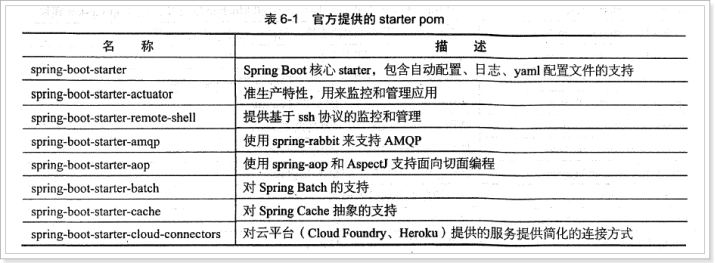
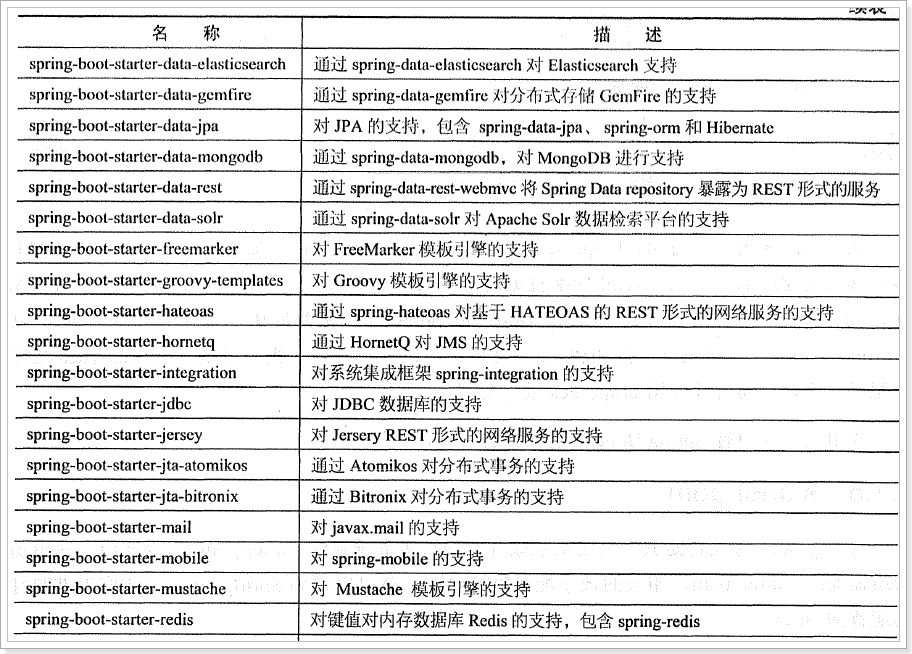
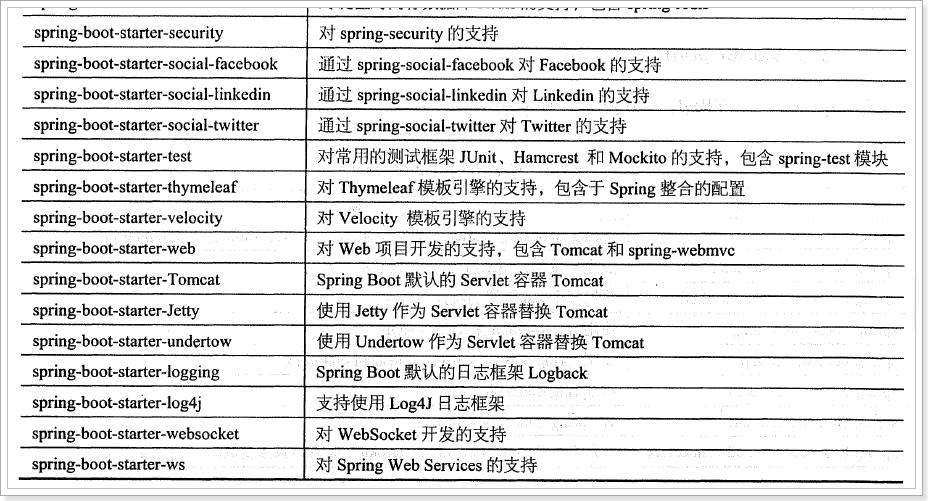
1.4.6. Xml 配置文件

1.4.7. 日志
Spring Boot对各种日志框架都做了支持,我们可以通过配置来修改默认的日志的配置:
#设置日志级别
logging.level.org.springframework=DEBUG
格式:
logging.level.*= # Log levels severity mapping. For instance `logging.level.org.springframework=DEBUG`
1.5. Spring Boot的自动配置的原理
Spring Boot在进行SpringApplication对象实例化时会加载META-INF/spring.factories文件,将该配置文件中的配置载入到Spring容器。
1.5.1. Maven下载源码
通过 dependency:sources 该命令可以下载该项目中所有的依赖的包的源码。
1.5.2. 源码分析
org.springframework.boot.SpringApplication:

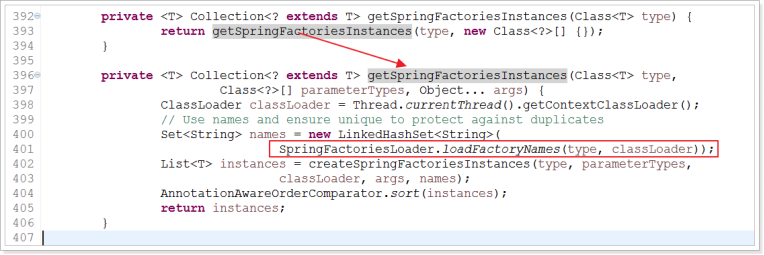
org.springframework.core.io.support.SpringFactoriesLoader:


由此可见,读取该配置文件来加载内容。
1.5.3. Spring.factories文件
# Initializers
org.springframework.context.ApplicationContextInitializer=\
org.springframework.boot.autoconfigure.SharedMetadataReaderFactoryContextInitializer,\
org.springframework.boot.autoconfigure.logging.AutoConfigurationReportLoggingInitializer
# Application Listeners
org.springframework.context.ApplicationListener=\
org.springframework.boot.autoconfigure.BackgroundPreinitializer
# Auto Configuration Import Listeners
org.springframework.boot.autoconfigure.AutoConfigurationImportListener=\
org.springframework.boot.autoconfigure.condition.ConditionEvaluationReportAutoConfigurationImportListener
# Auto Configuration Import Filters
org.springframework.boot.autoconfigure.AutoConfigurationImportFilter=\
org.springframework.boot.autoconfigure.condition.OnClassCondition
# Auto Configure
org.springframework.boot.autoconfigure.EnableAutoConfiguration=\
org.springframework.boot.autoconfigure.admin.SpringApplicationAdminJmxAutoConfiguration,\
org.springframework.boot.autoconfigure.aop.AopAutoConfiguration,\
org.springframework.boot.autoconfigure.amqp.RabbitAutoConfiguration,\
org.springframework.boot.autoconfigure.batch.BatchAutoConfiguration,\
org.springframework.boot.autoconfigure.cache.CacheAutoConfiguration,\
org.springframework.boot.autoconfigure.cassandra.CassandraAutoConfiguration,\
org.springframework.boot.autoconfigure.cloud.CloudAutoConfiguration,\
org.springframework.boot.autoconfigure.context.ConfigurationPropertiesAutoConfiguration,\
org.springframework.boot.autoconfigure.context.MessageSourceAutoConfiguration,\
org.springframework.boot.autoconfigure.context.PropertyPlaceholderAutoConfiguration,\
org.springframework.boot.autoconfigure.couchbase.CouchbaseAutoConfiguration,\
org.springframework.boot.autoconfigure.dao.PersistenceExceptionTranslationAutoConfiguration,\
org.springframework.boot.autoconfigure.data.cassandra.CassandraDataAutoConfiguration,\
org.springframework.boot.autoconfigure.data.cassandra.CassandraRepositoriesAutoConfiguration,\
org.springframework.boot.autoconfigure.data.couchbase.CouchbaseDataAutoConfiguration,\
org.springframework.boot.autoconfigure.data.couchbase.CouchbaseRepositoriesAutoConfiguration,\
org.springframework.boot.autoconfigure.data.elasticsearch.ElasticsearchAutoConfiguration,\
org.springframework.boot.autoconfigure.data.elasticsearch.ElasticsearchDataAutoConfiguration,\
org.springframework.boot.autoconfigure.data.elasticsearch.ElasticsearchRepositoriesAutoConfiguration,\
org.springframework.boot.autoconfigure.data.jpa.JpaRepositoriesAutoConfiguration,\
org.springframework.boot.autoconfigure.data.ldap.LdapDataAutoConfiguration,\
org.springframework.boot.autoconfigure.data.ldap.LdapRepositoriesAutoConfiguration,\
org.springframework.boot.autoconfigure.data.mongo.MongoDataAutoConfiguration,\
org.springframework.boot.autoconfigure.data.mongo.MongoRepositoriesAutoConfiguration,\
org.springframework.boot.autoconfigure.data.neo4j.Neo4jDataAutoConfiguration,\
org.springframework.boot.autoconfigure.data.neo4j.Neo4jRepositoriesAutoConfiguration,\
org.springframework.boot.autoconfigure.data.solr.SolrRepositoriesAutoConfiguration,\
org.springframework.boot.autoconfigure.data.redis.RedisAutoConfiguration,\
org.springframework.boot.autoconfigure.data.redis.RedisRepositoriesAutoConfiguration,\
org.springframework.boot.autoconfigure.data.rest.RepositoryRestMvcAutoConfiguration,\
org.springframework.boot.autoconfigure.data.web.SpringDataWebAutoConfiguration,\
org.springframework.boot.autoconfigure.elasticsearch.jest.JestAutoConfiguration,\
org.springframework.boot.autoconfigure.freemarker.FreeMarkerAutoConfiguration,\
org.springframework.boot.autoconfigure.gson.GsonAutoConfiguration,\
org.springframework.boot.autoconfigure.h2.H2ConsoleAutoConfiguration,\
org.springframework.boot.autoconfigure.hateoas.HypermediaAutoConfiguration,\
org.springframework.boot.autoconfigure.hazelcast.HazelcastAutoConfiguration,\
org.springframework.boot.autoconfigure.hazelcast.HazelcastJpaDependencyAutoConfiguration,\
org.springframework.boot.autoconfigure.info.ProjectInfoAutoConfiguration,\
org.springframework.boot.autoconfigure.integration.IntegrationAutoConfiguration,\
org.springframework.boot.autoconfigure.jackson.JacksonAutoConfiguration,\
org.springframework.boot.autoconfigure.jdbc.DataSourceAutoConfiguration,\
org.springframework.boot.autoconfigure.jdbc.JdbcTemplateAutoConfiguration,\
org.springframework.boot.autoconfigure.jdbc.JndiDataSourceAutoConfiguration,\
org.springframework.boot.autoconfigure.jdbc.XADataSourceAutoConfiguration,\
org.springframework.boot.autoconfigure.jdbc.DataSourceTransactionManagerAutoConfiguration,\
org.springframework.boot.autoconfigure.jms.JmsAutoConfiguration,\
org.springframework.boot.autoconfigure.jmx.JmxAutoConfiguration,\
org.springframework.boot.autoconfigure.jms.JndiConnectionFactoryAutoConfiguration,\
org.springframework.boot.autoconfigure.jms.activemq.ActiveMQAutoConfiguration,\
org.springframework.boot.autoconfigure.jms.artemis.ArtemisAutoConfiguration,\
org.springframework.boot.autoconfigure.flyway.FlywayAutoConfiguration,\
org.springframework.boot.autoconfigure.groovy.template.GroovyTemplateAutoConfiguration,\
org.springframework.boot.autoconfigure.jersey.JerseyAutoConfiguration,\
org.springframework.boot.autoconfigure.jooq.JooqAutoConfiguration,\
org.springframework.boot.autoconfigure.kafka.KafkaAutoConfiguration,\
org.springframework.boot.autoconfigure.ldap.embedded.EmbeddedLdapAutoConfiguration,\
org.springframework.boot.autoconfigure.ldap.LdapAutoConfiguration,\
org.springframework.boot.autoconfigure.liquibase.LiquibaseAutoConfiguration,\
org.springframework.boot.autoconfigure.mail.MailSenderAutoConfiguration,\
org.springframework.boot.autoconfigure.mail.MailSenderValidatorAutoConfiguration,\
org.springframework.boot.autoconfigure.mobile.DeviceResolverAutoConfiguration,\
org.springframework.boot.autoconfigure.mobile.DeviceDelegatingViewResolverAutoConfiguration,\
org.springframework.boot.autoconfigure.mobile.SitePreferenceAutoConfiguration,\
org.springframework.boot.autoconfigure.mongo.embedded.EmbeddedMongoAutoConfiguration,\
org.springframework.boot.autoconfigure.mongo.MongoAutoConfiguration,\
org.springframework.boot.autoconfigure.mustache.MustacheAutoConfiguration,\
org.springframework.boot.autoconfigure.orm.jpa.HibernateJpaAutoConfiguration,\
org.springframework.boot.autoconfigure.reactor.ReactorAutoConfiguration,\
org.springframework.boot.autoconfigure.security.SecurityAutoConfiguration,\
org.springframework.boot.autoconfigure.security.SecurityFilterAutoConfiguration,\
org.springframework.boot.autoconfigure.security.FallbackWebSecurityAutoConfiguration,\
org.springframework.boot.autoconfigure.security.oauth2.OAuth2AutoConfiguration,\
org.springframework.boot.autoconfigure.sendgrid.SendGridAutoConfiguration,\
org.springframework.boot.autoconfigure.session.SessionAutoConfiguration,\
org.springframework.boot.autoconfigure.social.SocialWebAutoConfiguration,\
org.springframework.boot.autoconfigure.social.FacebookAutoConfiguration,\
org.springframework.boot.autoconfigure.social.LinkedInAutoConfiguration,\
org.springframework.boot.autoconfigure.social.TwitterAutoConfiguration,\
org.springframework.boot.autoconfigure.solr.SolrAutoConfiguration,\
org.springframework.boot.autoconfigure.thymeleaf.ThymeleafAutoConfiguration,\
org.springframework.boot.autoconfigure.transaction.TransactionAutoConfiguration,\
org.springframework.boot.autoconfigure.transaction.jta.JtaAutoConfiguration,\
org.springframework.boot.autoconfigure.validation.ValidationAutoConfiguration,\
org.springframework.boot.autoconfigure.web.DispatcherServletAutoConfiguration,\
org.springframework.boot.autoconfigure.web.EmbeddedServletContainerAutoConfiguration,\
org.springframework.boot.autoconfigure.web.ErrorMvcAutoConfiguration,\
org.springframework.boot.autoconfigure.web.HttpEncodingAutoConfiguration,\
org.springframework.boot.autoconfigure.web.HttpMessageConvertersAutoConfiguration,\
org.springframework.boot.autoconfigure.web.MultipartAutoConfiguration,\
org.springframework.boot.autoconfigure.web.ServerPropertiesAutoConfiguration,\
org.springframework.boot.autoconfigure.web.WebClientAutoConfiguration,\
org.springframework.boot.autoconfigure.web.WebMvcAutoConfiguration,\
org.springframework.boot.autoconfigure.websocket.WebSocketAutoConfiguration,\
org.springframework.boot.autoconfigure.websocket.WebSocketMessagingAutoConfiguration,\
org.springframework.boot.autoconfigure.webservices.WebServicesAutoConfiguration
# Failure analyzers
org.springframework.boot.diagnostics.FailureAnalyzer=\
org.springframework.boot.autoconfigure.diagnostics.analyzer.NoSuchBeanDefinitionFailureAnalyzer,\
org.springframework.boot.autoconfigure.jdbc.DataSourceBeanCreationFailureAnalyzer,\
org.springframework.boot.autoconfigure.jdbc.HikariDriverConfigurationFailureAnalyzer
# Template availability providers
org.springframework.boot.autoconfigure.template.TemplateAvailabilityProvider=\
org.springframework.boot.autoconfigure.freemarker.FreeMarkerTemplateAvailabilityProvider,\
org.springframework.boot.autoconfigure.mustache.MustacheTemplateAvailabilityProvider,\
org.springframework.boot.autoconfigure.groovy.template.GroovyTemplateAvailabilityProvider,\
org.springframework.boot.autoconfigure.thymeleaf.ThymeleafTemplateAvailabilityProvider,\
org.springframework.boot.autoconfigure.web.JspTemplateAvailabilityProvider
1.5.4. 举例:Redis的自动配置
从上述的配置中可以看出,org.springframework.boot.autoconfigure.data.redis.RedisAutoConfiguration是Redis的自动配置。
内容:
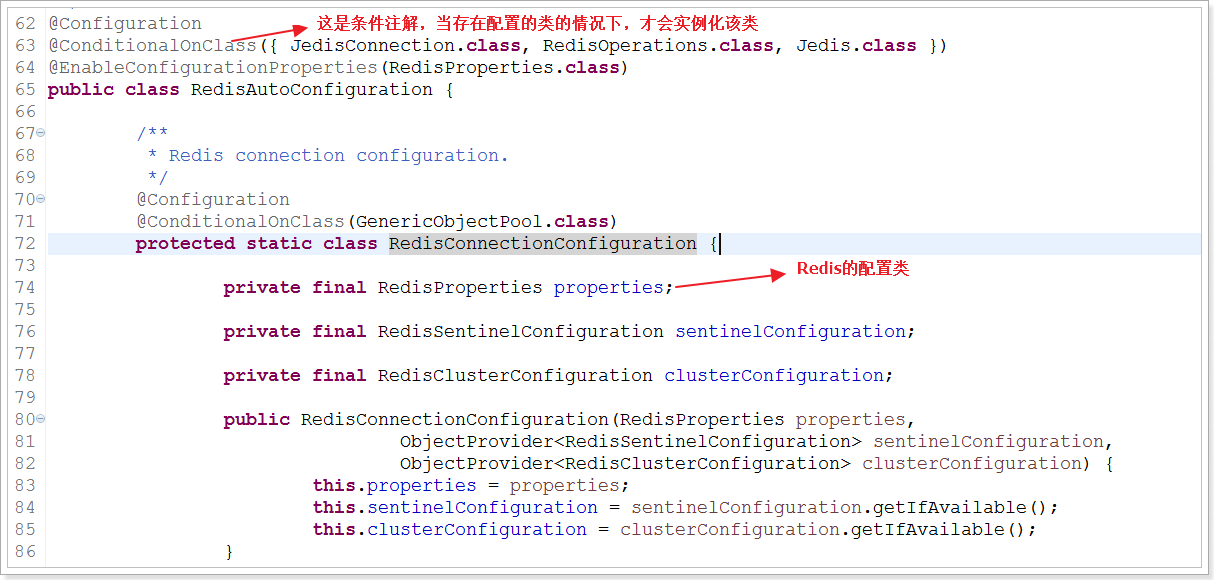
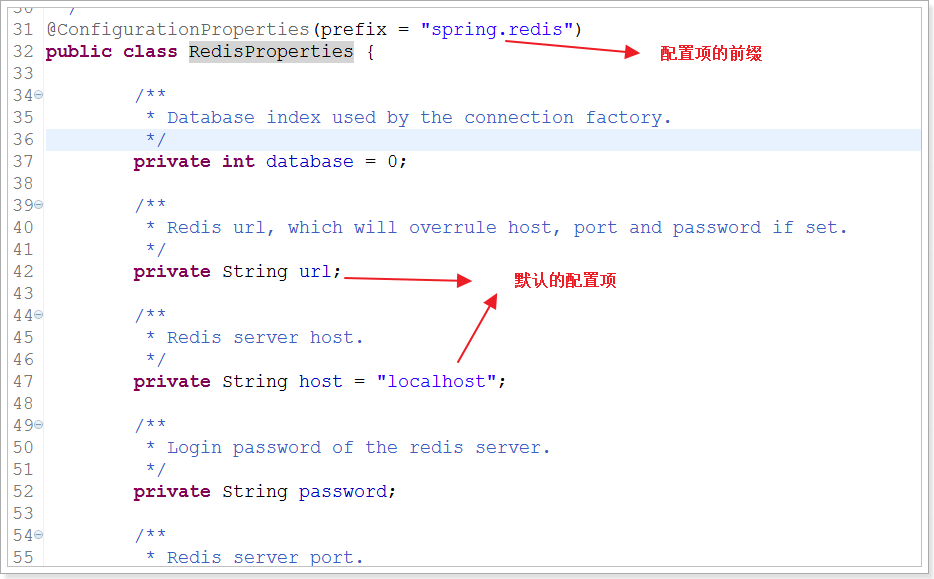
1.5.5. 条件注解

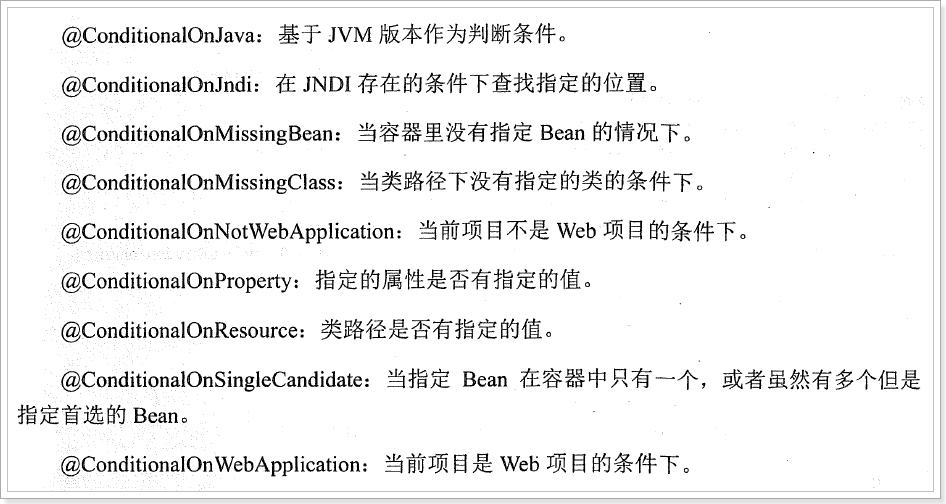
2. Spring Boot的web开发
Web开发的自动配置类:org.springframework.boot.autoconfigure.web.WebMvcAutoConfiguration
2.1. 自动配置的ViewResolver
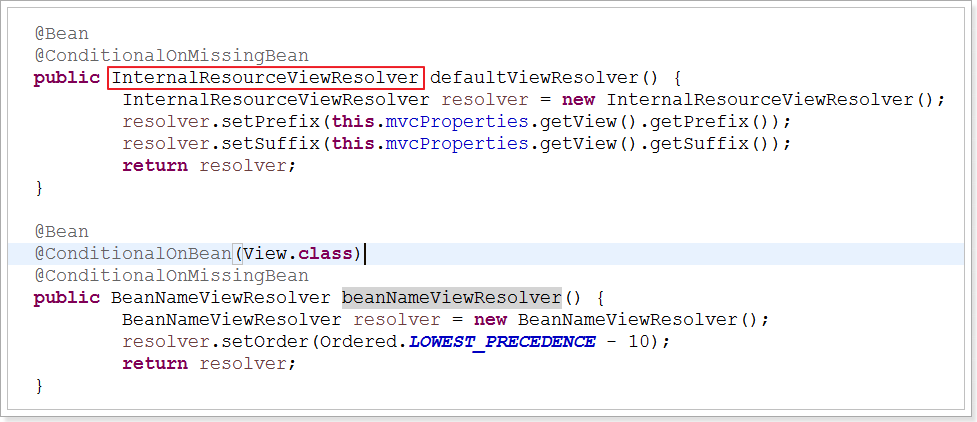
视图的配置mvcProperties对象中:
org.springframework.boot.autoconfigure.web.WebMvcProperties.View
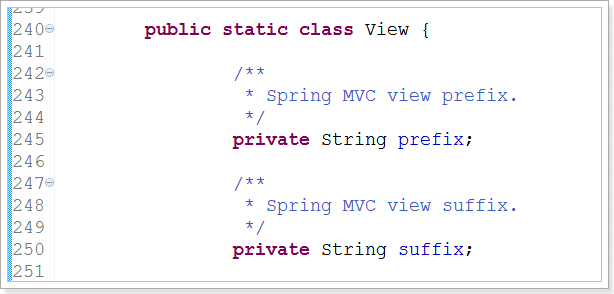
2.2. 自动配置静态资源
2.2.1. 进入规则为 /
如果进入SpringMVC的规则为/时,Spring Boot的默认静态资源的路径为:
spring.resources.static-locations=classpath:/META-INF/resources/,classpath:/resources/,classpath:/static/,classpath:/public/
测试:



2.2.2. 进入规则为*.xxx 或者 不指定静态文件路径时
将静态资源放置到webapp下的static目录中即可通过地址访问:
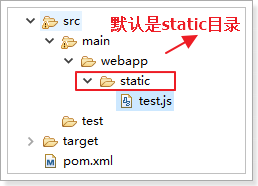
测试:

2.3. 自定义消息转化器
自定义消息转化器,只需要在@Configuration的类中添加消息转化器的@bean加入到Spring容器,就会被Spring Boot自动加入到容器中。
@Bean
public StringHttpMessageConverter stringHttpMessageConverter(){
StringHttpMessageConverter converter = new StringHttpMessageConverter(Charset.forName("UTF-8"));
return converter;
}
默认配置:

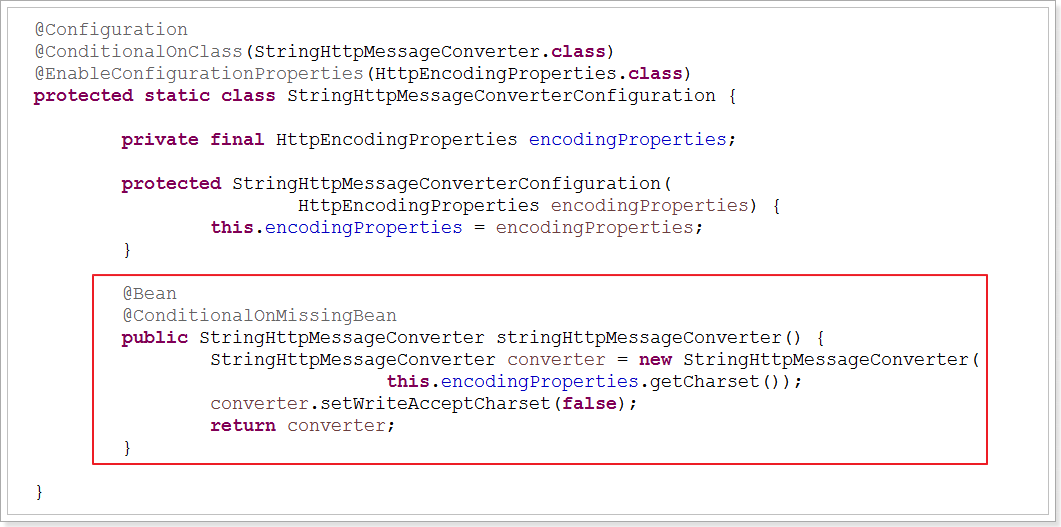
2.4. 自定义SpringMVC的配置
有些时候我们需要自已配置SpringMVC而不是采用默认,比如说增加一个拦截器,这个时候就得通过继承WebMvcConfigurerAdapter然后重写父类中的方法进行扩展。
import java.nio.charset.Charset;
import java.util.List;
import javax.servlet.http.HttpServletRequest;
import javax.servlet.http.HttpServletResponse;
import org.springframework.context.annotation.Configuration;
import org.springframework.http.converter.HttpMessageConverter;
import org.springframework.http.converter.StringHttpMessageConverter;
import org.springframework.web.servlet.HandlerInterceptor;
import org.springframework.web.servlet.ModelAndView;
import org.springframework.web.servlet.config.annotation.InterceptorRegistry;
import org.springframework.web.servlet.config.annotation.WebMvcConfigurerAdapter;
@Configuration //申明这是一个配置
public class MySrpingMVCConfig extends WebMvcConfigurerAdapter{
// 自定义拦截器
@Override
public void addInterceptors(InterceptorRegistry registry) {
HandlerInterceptor handlerInterceptor = new HandlerInterceptor() {
@Override
public boolean preHandle(HttpServletRequest request, HttpServletResponse response, Object handler)
throws Exception {
System.out.println("自定义拦截器............");
return true;
}
@Override
public void postHandle(HttpServletRequest request, HttpServletResponse response, Object handler,
ModelAndView modelAndView) throws Exception {
}
@Override
public void afterCompletion(HttpServletRequest request, HttpServletResponse response, Object handler,
Exception ex) throws Exception {
}
};
registry.addInterceptor(handlerInterceptor).addPathPatterns("/**");
}
// 自定义消息转化器的第二种方法
@Override
public void configureMessageConverters(List<HttpMessageConverter<?>> converters) {
StringHttpMessageConverter converter = new StringHttpMessageConverter(Charset.forName("UTF-8"));
converters.add(converter);
}
}
springboot的简单了解与使用的更多相关文章
- springboot+thymeleaf简单使用
关于springboot想必很多人都在使用,由于公司项目一直使用的是SpringMVC,所以自己抽空体验了一下springboot的简单使用. 环境搭建 springbooot的环境搭建可以说很灵活, ...
- Springboot接口简单实现生成MySQL插入语句
Springboot接口简单实现调用接口生成MySQL插入语句 在实际测试中,有这样一个需求场景,比如:在性能压力测试中,可能需要我们事先插入数据库中一些相关联的数据. 我们在实际测试中,遇到问题,需 ...
- SpringBoot 搭建简单聊天室
SpringBoot 搭建简单聊天室(queue 点对点) 1.引用 SpringBoot 搭建 WebSocket 链接 https://www.cnblogs.com/yi1036943655/p ...
- SpringBoot 发送简单邮件
使用SpringBoot 发送简单邮件 1. 在pom.xml中导入依赖 <!--邮件依赖--> <dependency> <groupId>org.springf ...
- SpringBoot入门 简单搭建和使用
前言 差不多两年前,那个时候我准备要做毕业设计了,才第一次知道java有框架这种东西,在网上找了好多SSM的教程,那会儿真的是Spring+SpringMVC+MyBatis搭建的,印象极深的是还要写 ...
- Element ui结合springboot的简单实战
Eelment UI简单实战 前端开发 1 创建项目,导入element ui(略) 2 大致设计出想要的效果,如下 3 创建包 根据设计的大致模样在项目的components中创建对应的包,方便以后 ...
- Java Springboot webSocket简单实现,调接口推送消息到客户端socket
Java Springboot webSocket简单实现,调接口推送消息到客户端socket 后台一般作为webSocket服务器,前台作为client.真实场景可能是后台程序在运行时(满足一定条件 ...
- 用SpringBoot搭建简单电商项目 01
前几节呢,我们已经简单介绍了SpringBoot框架的使用,从这一节开始,我们尝试着使用SpringBoot框架来一步一步搭建一个简单电商项目.当然了,这不是真正的电商项目,你可以看成是一个CRUD案 ...
- springboot实现简单的文件上传
承接上一篇,这里记录一下简单的springboot文件上传的方式 首先,springboot简单文件上传不需要添加额外的jar包和配置 这里贴一下后端controller层的实现代码 补一份前台的HT ...
- SpringBoot的简单登陆开发例子
1:这个例子用spirngboot整合mybatis,jdbc等技术开发的 2:步骤 2.1:新建一个工程 主要的两个步骤已经贴图了,第二张图是直接在pom.xml文件中加入依赖 2.2:新建完项目, ...
随机推荐
- Springboot 参数中传List
使用REST API时,经常会有get/delete方法需要传一个list的情况,如果使用post难免有点破坏规则,实际上参数传list是可以做到的 方法一: 后端代码如下: @DeleteMappi ...
- 【C/C++开发】C++实现简单的线程类
C++封装一个简单的线程类 多线程编程简介: 大家在编程时,经常需要在程序中启动一个或多个线程来处理任务,而如果每次都是去调用系统创建线程的API函数来创建,代码量虽不多,但线程的创建和业务逻辑代码就 ...
- 【数据库开发】如何创建MySQL数据库连接池(一个基于libmysql的MySQL数据库连接池示例(C/C++版))
http://blog.csdn.net/horace20/article/details/8087557 1. 一般架构说明 图 1 架构层次图 一般应用系统数据库访问模块可大致分为两层,一层 ...
- 项目中easyui-tooltip提示消息运用
easyui datagrid tooltip 对数据增加: {field:'roomCode',title:'房间名称',width:100 ,formatter: function (value, ...
- Jmeter CSV操作
统计行号列号 import java.io.BufferedReader; import java.io.FileReader; import java.io.File; print("== ...
- Greenplum 5.21.1 集群安装部署
简单来说GPDB是一个分布式数据库软件,其可以管理和处理分布在多个不同主机上的海量数据.对于GPDB来说,一个DB实例实际上是由多个独立的PostgreSQL实例组成的,它们分布在不同的物理主机上,协 ...
- 分布式架构下,session共享有什么方案么?
分布式架构下,session共享有什么方案么? 会点代码的大叔 科技领域创作者 分布式架构下的session共享,也可以称作分布式session一致性:关于这个问题,和大家说一说解决方案(如果有其他的 ...
- 数位dp踩坑
前言 数位DP是什么?以前总觉得这个概念很高大上,最近闲的没事,学了一下发现确实挺神奇的. 从一道简单题说起 hdu 2089 "不要62" 一个数字,如果包含'4'或者'62', ...
- Java语言资源国际化步骤
语言资源国际化步骤: 1. 定义资源文件(如:language),需要使用命令native2ascii命令进行转码:(native2ascii是jdk中的转码工具,在jdk的bin目录下) 2 ...
- 1263: 你会做蛋糕吗?(Java)
WUSTOJ 1263: 你会做蛋糕吗? 参考博客 Mitsuha_的博客 Description BobLee是个大吃货,喜欢吃好吃的,也喜欢做好吃的.比如做正方形的蛋糕.比如下图这个5*5的蛋糕. ...
